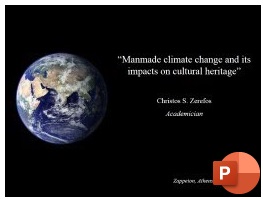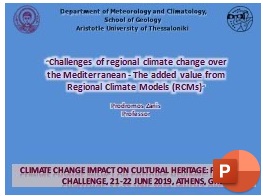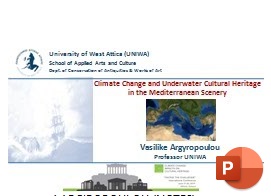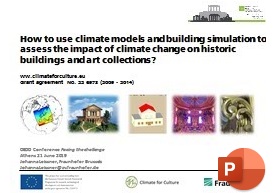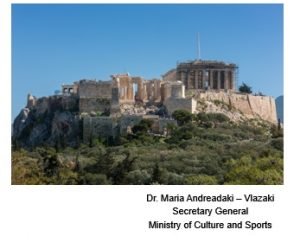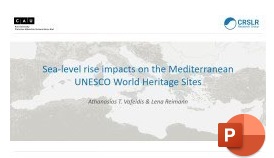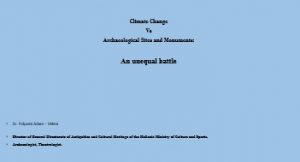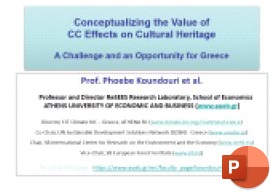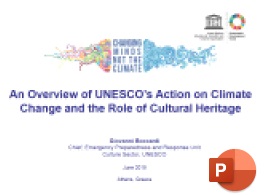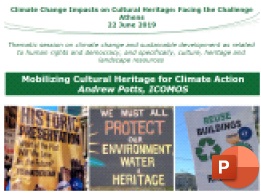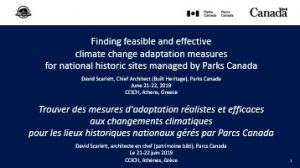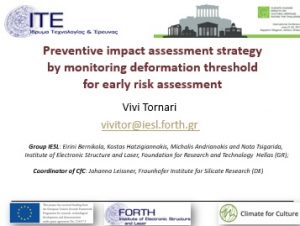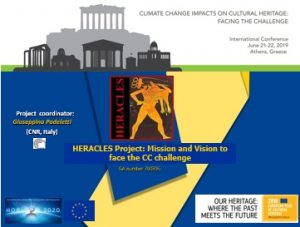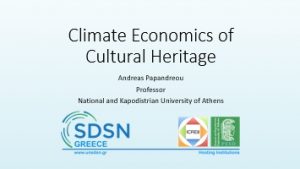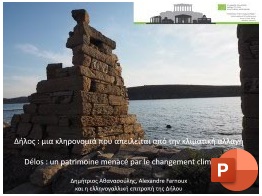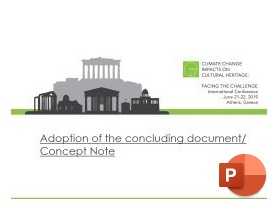Draft
Simultaneous interpretation will be provided from and into Greek, English, and French, during all sessions.
Theme 1.
Recording of impacts
09:00 - 09:30
Registration
09:30 - 10:00
Welcome Addresses
Welcome Addresses
- Mr. G. Katrougalos, Minister of Foreign Affairs
- Mr. C. Fotakis, Alternate Minister of Education, Research & Religion
- Mr. S. Famelos, Alternate Minister of Environment & Energy
10:00 - 10:20
“Manmade climate change and its impacts on cultural heritage”
C. Zerefos,, Professor, Head, Research Center for Climatology, Academy of Athens, Greece
“Manmade climate change and its impacts on cultural heritage”

Abstract
Cultural heritage is extremely vulnerable to natural phenomena and manmade interventions to our environment. The Mediterranean as the cradle of monuments and ideas of worldwide interest has been identified as the hot spot in a manmade destabilized climate. Exposure to changes is extreme events such as gale force winds, floods, landslides and sea level rise on top of a threatened by seismologically unstable soils threaten the Mediterranean with emphasis on the eastern part of this closed sea. Global warming has effects on ecosystems and is threatening agriculture and heritage areas in the long shorelines in Greece, Italy and elsewhere caused by intrusion of salt water in the groundwater table particularly near the shoreline. Cultural heritage may influence also religious culture in view of the expected large changes not only in air temperatures but also in humidity and comfort. Cultural heritage is more than ever threatened by the synergistic effects of global warming, forest fires and seismicity in large parts of the Globe. Examples of observed and expected changes will be discussed.
10:20 - 10:40
“Historical Climatology as an important discipline to study past climate, extremes and natural hazards and their impact on society and cultural heritage”
J. Luterbacher, Professor & Chair for Climatology, Climate Dynamics and Climate Change, Justus-Liebig University of Giessen, Germany
“Historical Climatology as an important discipline to study past climate, extremes and natural hazards and their impact on society and cultural heritage”
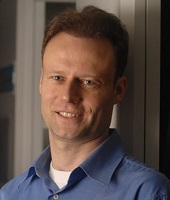
Luterbacher, J.,
Professor & Chair for Climatology, Climate Dynamics and Climate Change, Justus-Liebig University, University of Giessen, Germany
Abstract
Historical Climatology as an important discipline to study past climate, extremes and natural hazards and their impact on society and cultural heritage
Historical climatology is the use of documentary and written evidence to study historical changes in climate, extremes and their effect on human history and development. Historical Climatology follows two main goals:
- reconstructing temporal and spatial patterns of weather and climate including natural disasters and hazards (floods, storms, drought, heatwaves, earthquakes, fires, etc.) for the period prior to national meteorological networks,
- investigating the vulnerability of past societies and economies to climate variations, climate extremes and natural disasters.
Historical Climatology can contribute to the current debate on the long-term impacts of adverse climate conditions, extremes and natural hazards from a historical point of view. For instance, the study of historical flooding with respect to meteorological causes, frequency, severity and human impacts and damages on cultural heritage and historical monuments provides important information in developing future flood risk management strategies.
The talk presents the tools used by historical climatologist and shows different examples of past natural disasters and extremes from Europe and the Mediterranean and how they have affected human affairs and led to material damage.
10:40 - 11:00
“Challenges of regional climate change over the Mediterranean - The added value from Regional Climate Models (RCMs)”
P. Zanis, Professor, Department of Meteorology and Climatology, Aristotle University of Thessaloniki, Greece
“Challenges of regional climate change over the Mediterranean - The added value from Regional Climate Models (RCMs)”

Zanis, P.,
Professor, Department of Meteorology and Climatology, Aristotle University of Thessaloniki, Greece
Abstract
Regional climate models (RCMs) are well established tools for the application of dynamical downscaling methods to enhance the regional information provided by Global Climate Models (GCMs) or by the large scale reanalysis. The added value of using RCMs is their ability to simulate atmospheric processes at a wide range of spatial and temporal scales because they represent topographical features in more detail due to their higher resolution. The Mediterranean region is characterized by complex mountain topographies, coastlines, small islands and peninsulas and hence downscaling to higher resolution is necessary for regional climate change impact studies. Reliable and user friendly open access of ensembles of future climate change data from high resolution RCM projections are essential to support decision makers, stakeholders, intermediary users and end-users for climate change impacts, mitigation and adaptation. The need of user friendly interactive web application tools for data extraction from RCMs is discussed.
11:00 - 11:30
Coffee Break
11:30 - 11:50
“Climate Change and Underwater Cultural Heritage in the Mediterranean Scenery”
V. Argyropoulou, , Professor, Uniwa, Greece
“Climate Change and Underwater Cultural Heritage in the Mediterranean Scenery”
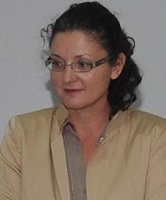
Abstract
Research of Climate Change (CC) impacts on Cultural Heritage (CH) has mostly focused on land CH or CH located along coastlines, with little concern being placed on Underwater Cultural Heritage (UCH). However, it is said that there is more history underwater than in all the museums of the world combined, especially in the Mediterranean Region. The geographical particularities of this region, and the commercial and cultural interaction through Mediterranean sea-roads have strongly affected maritime traditions that go back at least 5,000 years. These traditions can, among others, be identified in sunken shipwrecks and their contents located at the sea bottom, which are unique in the sense that they encapsulate a single moment in time, and are comparable to rare land examples such as Pompeii or Thera. CC impacts on the sea, i.e. warming of oceans, changing of its chemical composition (acidity and salinity), shifting of currents’ pattern etc., places UCH at yet unidentified risks. The presentation will attempt to explore potential CC-related risks of UCH in the Mediterranean scenery, while highlighting the need for baseline research of UCH made from different materials in order to better assess these impacts and make more informed and sustainable management plans for UCH from different periods.
Presentation
Press image to see the presentation
11:50 - 12:10
“From Deduction to Prediction! Examining the Impact of Climate Change on Cultural Heritage”
R. Jigyasu,, Programme Officer ICCROM Athar regional Conservation Center in Sharjah, India
“From Deduction to Prediction! Examining the Impact of Climate Change on Cultural Heritage”

Abstract
From Deduction to Prediction! Examining the Impact of Climate Change on Cultural Heritage
By Dr. Rohit Jigyasu, Programme Officer, ICCROM
Vice President, ICOMOS International
Climate change is increasing the number of disasters and their devastating impacts. From 1988 to 2007, 76% of all disaster events were hydrological, meteorological or climatological in nature. The likelihood of increased weather extremes in future therefore gives great concern that the number or scale of weather-related disasters will also increase. Climate change related disasters have wider physical, environmental, social and economic impacts. These directly or indirectly also impacts cultural heritage of various types ranging from monuments to historic towns and cultural landscapes. As a result, various tangible and intangible attributes of Cultural heritage would be increasingly affected leading to loss of values. However there is disconnect between various initiatives undertaken for climate change adaptation, disaster risk reduction and heritage conservation at policy, planning and institutional levels. This would necessitate bringing together agendas for development, disaster risk reduction and climate change and variability and focusing on mitigation and preparedness. Also cultural heritage concerns should be mainstreamed into disaster risk reduction and climate change adaptation at multiple levels. The paper will detail out impacts of cultural heritage due to climate change and suggest ways of integrating climate change and disaster risk reduction agenda in heritage management policies and practices.
12:10 - 12:30
“How to use climate models and building simulation to assess the impact of climate change on historic buildings and art collections”
J. Leissner,., Dr., Scientific Representative, “Fraunhofer”, Germany
“How to use climate models and building simulation to assess the impact of climate change on historic buildings and art collections”
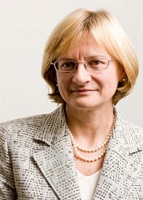
Abstract
Climate change is one of the most important global challenges of our time. Although many studies have been conducted to explore its impact on e.g. biodiversity and agriculture, little is known as to whether and to what extent climate change influences cultural heritage assets. Against this background, the EU-funded "Climate for Culture" project (2009-2014) has investigated the potential impact of changing climate conditions on historic buildings and the collections they contain as well as on the future energy demand in Europe and the Mediterranean. Art objects are often very sensitive to variations in humidity and temperature. The main innovation was to use a combination of simulation and modelling tools to predict more accurately the influence of changing outdoor climate on the indoor and microclimate in historic buildings until 2100. Further, future energy demand for climatisation of historic buildings was calculated. By using an automated procedure an assessment of the damage potential in various climate zones was performed. In order to assess the damage potential of these future climatic conditions, a set of damage functions has been applied to four categories of objects (sculptures, panel paintings, furniture and paper manuscripts). Furthermore, sensitive glass sensors developed within the EU project AMECP (1993-1996) have been used in “Climate for Culture” to assess the corrosive damage potential of current outdoor and indoor climates at the case study sites. Glass sensors act in an integrating way as dosimeters, i.e. they monitor the combined corrosive effects (in the present case, of temperature and humidity) on a longer time scale as well as daily fluctuations.
Presentation
Press image to see the presentation
12:30 - 13:30
Lunch Break
13:30 - 13:50
“Manmade activities and their impact on monuments: the Acropolis case”
M. Vlazaki Andreadaki, , General Secretary of Culture, Greece
“Manmade activities and their impact on monuments: the Acropolis case”

Abstract
Anthropogenic activities and their impact on monuments: The case of the Acropolis.
The phenomenon of climate change, the occurrence of extreme weather phenomena and the degradation of the environment, especially in the urban centers, also affects the monuments which have stood for centuries. Indeed, many claim that the damage suffered in recent decades far exceeds the damage of the past. Our speech attempts to illustrate the data as well as measures to address the adverse effects of human activities on monuments, with particular reference to the emblematic monuments of the Acropolis.
Press image to see the presentation
13:50 - 14:10
“Notable impacts of climate change on Armenian historical monuments of Architecture”
D. Kertmenjian, , Doctor of Architecture, Leading Researcher at the Department of Diaspora's Armenian Art and International Relations of the Institute of Arts of the National Academy of Sciences of RA, Armenia
“Notable impacts of climate change on Armenian historical monuments of Architecture”

Abstract
Notable is the effect of climate changes on preservation of historical monuments in last decades. That so very urgent is the update of documentary information of the case. The State of the Art are the damages and deterioration noticed because of new natural-climatic conditions. The main problem of the research is the fixation and stabilization of the changes occurred. The objectives include: 1. The definition of the climatic impacts, 2. Beside soil media reactions concentration on of “ Mitis” type layered masonry technique in Armenia and its notable behavior towards new changes, 3. Hasty Diagnosis and mapping on three case studies carried out. Methodology is the qualitative study and comparative analysis of the damages in behalf of back weathering, dilapidation and condensation or desalination aspects noticed on newly treated parts.
14:10 - 14:30
“Ecosystem based approach for climate adaptation in Kune Vain Lagoon, Lezha, Albania”
O. Çuçi, , Deputy Minister of Ministry of Tourism and Environment of Albania
“Ecosystem based approach for climate adaptation in Kune Vain Lagoon, Lezha, Albania”

Abstract
Lezha region is situated on the coastal zone of Adriatic Sea, a cross road to north of Albania. It is rich in historical sites and cultural heritage with castles and sites from medieval age. Due to climate changes and alteration of the landscape by human settlements and tourism development, it is facing frequently flood events due to torrential storms. Furthermore, the nearby Kune-Vain lagoon, a nature touristic site, very rich on birds and other animal habits, is threatened by sea level raise and habitat loss. A number of adaptive measures and interventions are made based on ecosystem services such as reforestation, dune restorations, maintain the water communication flow with the sea, as well as community involvement and education.
Press image to see the presentation
14:30 - 14:50
“The role of climate in Museum Buildings. Albanian Case Studies”
E. Bushati, , Vice Dean of Faculty of Architecture and Urbanism, Albania
“The role of climate in Museum Buildings. Albanian Case Studies”
Abstract
Museums are housed in buildings designed for museum but often they are housed in buildings which are not designed and build for this purpose. These two main museum building typologies can fulfill different indoor climates for artefacts preservation. Seeing in this complexion, the building is a buffer volume which plays the main role in mitigating the external climate. Building design, construction and the building technologies affects building performance and as a result the indoor climate. For the preservation of the artefacts in a museum the indoor climate is often restricted to a narrow interval for temperature, but most of all for relative humidity. These standards for temperature and relative humidity, however, does not fit well in some museum buildings. For this reason, today’s museum standards for artefacts preservation must be verified and evaluated based on real site measurements. The monitored parameters should be interpreted starting initially from the building design, building materials and building technology.
For some typical Albanian museums case studies have been done to show how the physical building effects the museum climate. Three well known Albanian museums are selected to be examined; The National Historic Museum, the Archeological Museum of Tirana and the Iconographic Museum “Onufri” of Berat. The three examined museum buildings represent different museum building typologies as well as different construction technologies. The National Historic Museum is a building designed to be a museum and is one of the most representative buildings of this typologies. It is constructed in 1981 and the construction technologies are considered as advanced for the period. The Archeological Museum and the Iconographic Museum “Onufri” represent the museum buildings that are not build for this purpose but are used as museum buildings. The Archeological Museum is housed in a building designed by Italian architect G.Bosio in 1939 embodying the construction technologies of the period when it was built. The Iconographic Museum “Onufri” is housed in the Saint Mary church that is the most representative church of Albanian post-Byzantine architecture. It is constructed in 1797.
Buildings are analyzed in a methodological way. The process of selecting buildings is based on well-defined criteria. The monitored buildings should represent different museum typologies, were built in different periods, were identified as problematic during the site visits and also is taken into consideration the cultural, social and economic importance of the selected buildings in the Albanian museums network.
For a measurement period, at least one year, are done records of Temperature and Relative Humidity in different indoor environments of the three mentioned above buildings. The measurements are done in a narrow frequency (each 15 minutes) with electronic data loggers. The values and the results compared between the three buildings. Analyses of thermo hygrometric parameters (T and LR) showed that there is a contrast among indoor climates of these buildings. Each building appears with its own indoor climatic characteristics, depending on the type of building, construction characteristics and the level of building degradation. The study interprets the data after it is analyzed the construction technology for each building and proposes the strategy to improve the preservation conditions.
Key words: Museum building, building technology, temperature, relative humidity, preservation
14:50 - 15:20
Coffee Break
15:20 - 15:40
“Sea-level rise impacts on the Mediterranean UNESCO World Heritage Sites”
A. Vafeidis, , Prof. Dr, Kiel University, Group Leader, Coastal Risks and Sea-Level Rise Research Group, Germany
“Sea-level rise impacts on the Mediterranean UNESCO World Heritage Sites”

Abstract
Athanasios T. Vafeidis & Lena Reimann
Climate-induced sea-level rise is exacerbating the risk of coastal hazards, such as flooding and erosion, directly threatening UNESCO World Heritage sites (WHS) located in coastal areas. The Mediterranean region has a particularly high concentration of cultural WHS in coastal locations as several ancient civilisations have developed in the region. This study presents an index-based approach that allows for assessing and forecasting WHS at risk from coastal flooding and erosion in the Mediterranean under four sea-level rise scenarios, until 2100. We show that, already today, 37 out of 49 cultural WHS located in low-lying coastal areas of the Mediterranean are at risk from a 100-year flood and 42 from coastal erosion. Until 2100, flood risk may increase by 50% and erosion risk by 13% across the region, with considerably higher increases at individual sites. Most affected countries include Italy, Croatia, Greece and Tunisia. These results provide a first-order assessment of where adaptation is most urgently required. Our findings can be used by policymakers to steer detailed research at local-scale, which can provide the necessary information for devising innovative adaptation strategies particularly suited to the characteristics of each specific WHS.
Presentation
Press image to see the presentation
15:40 - 16:00
“Climate Change versus Archaeological Sites and Monuments: an unequal battle”
P. Veleni-Adam, , Dr, Archeologist, Director of the General Directorate of Antiquities and Cultural Heritage, Greece
“Climate Change versus Archaeological Sites and Monuments: an unequal battle”

Abstract
The climate change is always a major concern because it can cause natural disasters and serious damage to World Cultural Heritage. This is particularly so today because many natural disasters are brought about, or increased, by climate change throughout the world. The extreme weather conditions cause drought, fires, flooding from rivers and lakes and affect the natural and cultural environments in Greece.
Reducing and managing the risk of natural disasters are significant challenges before the world community. Climate change and natural disasters are the consequences of uncontrolled human activity and poor environmental management, bringing damage to World Heritage monuments.
Presentation
Press image to see the presentation
16:00 - 16:20
“Impact of natural disasters on cultural sites – Lessons from Greece”
E. Lekkas,, Professor, Faculty of Geology and Geoenviroment, National and Kapodistrian University of Athens, President, Earthquake Planning and Protection Organization, Greece
“Impact of natural disasters on cultural sites – Lessons from Greece”

Abstract
Greece and the broader Easter Mediterranean have very dynamic geomorphological, environmental and geodynamic regime, that provided a very unique landscape to its inhabitants since prehistoric times. The scenic landforms that were shaped by the constant natural processes and the abundance of hazardous phenomena of the region, such as floods, earthquakes, volcanos, were to a degree part to the ancient societies and their heritage. Their symbiosis, one that lasts for thousands of years, has transferred to our modern societies the responsibility to protect the remnants of this heritage. In the Greek landscape, natural disasters are looming over numerous invaluable cultural sites. Using modern tools we are in the process of understanding the natural risks that threaten cultural sites, especially from new challenges arising from climate change and the associated the intensification of hydro-meteorological and climate-related hazards.
16:20 - 16:40
“The Socio-Economic Value of Culture: Estimating of Climate Change Effects”
P. Koundouri, , University of Economics & Business, Greece
“The Socio-Economic Value of Culture: Estimating of Climate Change Effects”

Abstract
In October 2018 the IPCC special report on “Global Warming of 1.5 ºC” warned that there are only a dozen years for global warming to be kept to a maximum of 1.5C, beyond which, even half a degree will significantly worsen the risks of drought, floods, extreme heat and poverty for hundreds of millions of people around the globe. Urgent and unprecedented changes are needed to reach the target. Such a transition can be achieved by developing structured and methodologically sound approaches to recognizing, demonstrating and capturing the Total Economic Value of resources.
Although research on the economic and social effects of climate change on cultural resources and services, is not extensive, my contribution will focus on the methods available to estimate and monetize these effects and understand the social value of conserving culture. Central to my speech will be the concept of the ‘total economic value' and in particular the value humans derive from cultural resources, within a framework of climate change, uncertainty and ambiguity. The estimation of this value is crucial for understanding how much it should be invested in order to conserve cultural goods and services, as well as develop efficient policies for sustainable cultural management.
The speech will present my research on refining theoretical models and empirical methods used in the field of economics, towards: (a) better understanding of the concept and determinants of the total economic
value of cultural goods and services, (b) more accurate modelling of this value, (c) more robust estimation of this value, (d) more efficient integration of this value in interdisciplinary cultural management and policy-making, while (e) incentivizing the development of technological and social innovations that integrate this value and accelerate these innovations in the market.
Presentation
Press image to see the presentation
20:30
Dinner for the Speakers at the Acropolis Museum
(by invitation only)
Before dinner, guests will hear from Professor Th. P.Tassios, who will address the topic: “Views of the Ancient Greeks on the environment”
“Views of the Ancient Greeks on the environment”

Abstract
In Greek Mythology, several plants and animals were considered sacred and were protected. The Presocratic philosophers, who taught that we all belong to a “Cosmic Ensemble”, paved the way for the respect to Nature. During the classical period, Plato himself was very much concerned with the damaging effects of mountain deforestation on the distribution of rainwater that would, as a consequence, flow rapidly to the sea and be wasted. Aristotle supported the idea of a “common substance” of all living species. He also predicted, in his Meteorologika, the risk of some humid regions becoming arid. Finally, it is remarkable that, thanks to their correct heliocentric beliefs and their knowledge of the Earth’s sphaerical form, the Greeks undermined the anthropocentric view of a flat Earth, centre of the universe, offered by the Gods to the humans as a gift to be exploited unconditionally.
09:10 - 09:30
“Impacts of climate change on cultural heritage: The Role of PolicyMakers”
J. Herrera, Minister for the Environment, Sustainable Development and Climate Change, Republic of Malta
“Impacts of climate change on cultural heritage: The Role of PolicyMakers”

Abstract
Climate change is posing a serious threat to our environment, socio-economic development and infrastructures. Our cultural heritage is equally at risk. Action is so required, addressing the necessary legislative frameworks for the implementation of measures, which could mitigate the deterioration of our cultural sites, caused by intense weather phenomena, floods, heat waves, storms and temperature raise. The policy makers have a role in this. Us, the decision makers need to ensure concrete responses and promotion of research and innovation and sharing of best practices in a way to preserve our heritage sites from climate change, for us and our future generations.
09:30 - 09:50
“An Overview of UNESCO’s Action on Climate Change and the Role of Cultural Heritage”
G. Boccardi, , Programme Specialist Culture & Emergencies / Emergency Preparedness and Response Unit, Unesco Culture Sector, Italy
“An Overview of UNESCO’s Action on Climate Change and the Role of Cultural Heritage”

Abstract
My presentation will provide an overview of the policy framework related to climate change and cultural heritage at UNESCO, with particular emphasis on the challenges that needs to be addressed by UNESCO and its Member States. It will also present the key materials, tools and initiatives that have been developed over the years, notably in the World Heritage context, as well as those that could be undertaken in the future, emphasizing in particular the opportunities associated with the implementation of the Paris Agreement in harnessing the potential of heritage for CC adaptation. Finally, some reflections will be shared on the long-term implications of climate change, in cultural terms, for our societies, and on how this may affect the heritage sector.
Presentation
Press image to see the presentation
09:50 - 10:10
“Impact of climate changes on cultural heritage in Czech Republic”
S.I. Jaresova, , Directorate General, the landscape architect - specialist in historical gardens and landscape, Czech Republic
“Impact of climate changes on cultural heritage in Czech Republic”

Abstract
Historic Gardens, Parks and artificially composed Landscape are very specific fragile ”Green Monuments”.
The impact of climate changes is evident in many aspects and terms of manifestations of excessive drought and slow global warming with a direct impact on groundwater levels.
Through the all levels of protection, we realized very deteriorated health condition of trees, which has a strong influence on the composition of the green monuments.
The trees are gradually drying out and later dying or they are attacked by the various insects (wood-destroying), eventually by fungal diseases. Vast areas of woods and parks are infected and have to be cut down (some examples from our territory will be demonstrate/presented).
In my lecture I’ll concentrate to the most important problems of the monument protection like:
- Forms and methods of preservation and presentation of green monuments affected by climate changes
- Necessity to keep water in the landscape, renew the original retention reservoirs, historical ponds, sewers and complete the renewal of water management systems.
- Planning and working on the possibilities of rainwater retention with the use of modern elements.
On all these tasks we are closely cooperating with ministry of agriculture, environment, social affairs, as well as transportation. As the most important and crucial aim we consider the moment how to retain rain water in cultural landscape.
10:10 - 10:30
“Mobilizing the cultural heritage sector for climate action: an introduction to the ICOMOS Climate Change and Heritage Working Group”
A. Potts, , JD, Co-Chair, ICOMOS, Climate Change and Heritage Working Group, Nixon Peabody LLP, USA
“Mobilizing the cultural heritage sector for climate action: an introduction to the ICOMOS Climate Change and Heritage Working Group”

Abstract
Mobilizing the cultural heritage sector for climate action: an introduction to the ICOMOS Climate Change and Heritage Working Group”.
In December 2017, the Triennial ICOMOS General Assembly meeting in New Delhi, India adopted Resolution 19GA 2017/30 entitled “Mobilizing ICOMOS and the Cultural Heritage Community To Help Meet the Challenge of Climate Change.” The CCHWG was formed to advance the Resolution’s ambitious mandate. The Group is currently working on a variety of initiatives around the world in line with ICOMOS’s view that heritage sites as well as local communities' intangible heritage, knowledge and practices constitute an invaluable repository of information and strategies to address climate change, even while those resources are themselves at risk from climate impacts.”
Presentation
Press image to see the presentation
10:30 - 11:00
Coffee Break
11:00 - 11:20
“Finding feasible and effective climate change adaptation measures for national historic sites managed by Parks Canada”
D. Scarlett, , Chief Architect (Built Heritage), Canada
“Finding feasible and effective climate change adaptation measures for national historic sites managed by Parks Canada”

Abstract
Chief Architect (Built Heritage)
Indigenous Affairs and Cultural Heritage Directorate
Parks Canada / Government of Canada
Finding feasible and effective climate change adaptation measures for national historic sites managed by Parks Canada.
Parks Canada is mandated to protect and present nationally significant examples of Canada's natural and cultural heritage, including 171 national historic sites across the country located in vastly different geographic settings and climatic zones. Parks Canada is increasingly having to deal with the effects of climate change at its sites, including (but not limited to) increased wildfire, permafrost thaw, sea level rise, extreme temperatures and windstorms, and sustained heavy rainfall and flooding. Mr. Scarlett’s presentation will share Parks Canada’s current approach to identifying climate change vulnerabilities and risks at its heritage places, and its work to find feasible and effective adaptation measures to face climate change. The presentation will reference the findings of climate change adaptation workshops Parks Canada has held across the country - from Newfoundland to the Yukon Territory - and the tools and processes it is using to develop ‘best practices’ for responding to climate change at heritage places.
Presentation
Press image to see the presentation
11:20 - 11:40
“Preventive impact assessment strategy by monitoring deformation threshold for early risk assessment”
V. Tornari, , Head of Holography Metrology lab, IESL/FORTH, Greece
“Preventive impact assessment strategy by monitoring deformation threshold for early risk assessment”
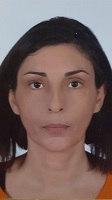
Abstract
Due to climate change and temperature increase a variable environmental impact is experienced by artistic and historical structures. Especially relative humidity (RH) fluctuations are known to affect the equilibrium moisture content of materials forcing them to a constant displacement in an effort to reach or keep in equilibrium with surrounding environment. Each change to maintain equilibrium leads to transient structural distortion. In controlled environments, for example Museums, maintaining equilibrium ranges in values usually within the safe distortion limits. Repeated deformation within the distortion limits causes a slow but steady ageing, while the off-limits distortion can jeopardise structural integrity and lead to irreversible damage. The persistent effort of materials to maintain equilibrium may endanger structural integrity and lead to irreversible damage even within assumed safety limits.
A preventive strategy for preserving cultural heritage from climate impact should be based on measures to monitor, assess and predict the critical phases of deterioration, whether within or outside the safe boundaries, to take timely measures that prevent further structural deterioration and lead to irreversible wear and tear. In preventive conservation implementing measures that could foresee in advance the turn of critical phases of deterioration and prevent further deterioration and fracture is thus becoming a necessary step.
The direct quantitative monitoring of surfaces has been experimentally tested and a feasible way of understanding the climate impact from objects reactions has been confirmed. A portable system based on remote real-time high-information content coherent interferometry has been developed to allow the automatic and remote acquisition of sequential high-resolution full-field surface images by recording the surface deformation changes on hygroscopic materials used in cultural heritage during cycles of induced RH changes. Deformation as a respond to RH change provides a risk index termed deformation threshold. Depending on material parameters the deformation threshold differ significantly allowing thus a classification of environmental risk according to deformation threshold of material at risk. The material responds immediately to RH change depending on specific parameters and age. The deformation threshold differs accordingly.
The remote monitoring of reactions with a classified index of deformation threshold to characterise environmental risk it was firstly developed in the experimental workpackage of Climate for Culture European project (FP7-ENV-2008-1 CfC no. 226973). It allowed the development of a preventive methodology assessed through threshold violation recorded directly from surface responses. Indication of the natural onset of deterioration was traced long before visible damage, allowing thus potential preventive measures to be taken in advance.
An ongoing study (in cooperation with C2RMF and Louvre Museum) aims to certify the altered deformation threshold values as reference values prior to the onset of deterioration; and classify the warning signal of deformation threshold in regards to risk urgency.
Presentation
Press image to see the presentation
11:40 - 12:00
“HERACLES Project: Mission and Vision to face the CC challenge”
G. Padeletti, , National Research Council in Italy (Climate Change Impacts on Cultural Heritage, HERACLES project), Italy
“HERACLES Project: Mission and Vision to face the CC challenge”
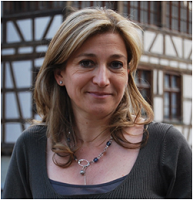
Abstract
Europe has a significant cultural diversity together with exceptional ancient architectures attracting millions of tourists every year. This incalculable value and global assets have to be preserved for future generations. The effects of floods, extreme wind, storms, rains on these ancient and fragile assets are seriously amplified. Advanced techniques, commonly used for modern structures, cannot be applied to preserve their originality. To preserve ancient valuable structures, dedicated technique, material and methodologies have to be applied. In order to address all the above challenges, the concept underpinning HERACLES project is to propose a holistic, multidisciplinary and multi-sectorial approach with the aim to provide an operative system and eco-solutions to innovate and to promote a strategy and vision of the future of the CH resilience. The HERACLES vision is tested in Greece and in Italy.
Presentation
Press image to see the presentation
12:00 - 12:20
“The world heritage on Brazilian soil: conservation challenges in a climate variability scenario”
S.H. Zanirato, , Professor of Environmental Management Course at the University of São Paulo. Coordinator in Brazil to the UNESCO Chair Tourism, Culture and Development, Brazil
“The world heritage on Brazilian soil: conservation challenges in a climate variability scenario”
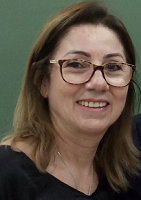
Abstract
Firstly, I will start by giving the audience an overview of the global climate change, mentioning the importance of adopting a more realistic view of the problem. Next, I will give information about the climate change in Brazil and the future scenarios from the Brazilian Model of Climate Changes, mentioning the current risks to its cultural and natural heritage, caused by urban expansion, the advance of the agricultural frontier, and also the growth in tourism. Then, I will also discuss future risks such as the rise of sea level in coastal cities, the Amazon forest turning into a savanna, and the significant loss in biodiversity of the South Atlantic Ocean islands. Furthermore, I will tackle the challenges of political actions regarding the control of these risks, which involve social participation, both in terms of recognizing the global climate changes, and facing the risks to the cultural and natural heritage.
12:20 - 12:40
“Conceptualizing the value of culture”
A. Papandreou, Professor in the Economics Department of the University of Athens, Greece
“Conceptualizing the value of culture”

Papandreou, A. Professor in the Economics Department of the University of Athens
Presentation
Press image to see the presentation
12:40 - 13:00
“Some adaptation measures mitigating the impact of climate change on heritage”
E. Kyriakidis, , Senior Lecturer in Aegean Prehistory, University of Kent, UK
“Some adaptation measures mitigating the impact of climate change on heritage”

Abstract
Climate change is a phenomenon that has been happening through the ages. Archaeological evidence indeed supports the existence of multiple periods of climate change, some of which were partly induced by humans. Global warming is however a particularly worrying and acute phenomenon with multiple repercussions on cultural heritage world wide. It is important however to be realistic and accept that the heritage world can do very little other than raise awareness to prevent global warming. What it can do is work to mitigate its effects. The Heritage Management Organization has a set of advice for heritage managers that have been distilled from its decade long scientific experience on the topic.
Presentation
Press image to see the presentation
13:00 - 13:20
“Délos : un ensemble immobilier menacé par le changement climatique”
D. Athanasoulis,, Dr., Aristotle University of Thessaloniki, Greece
and A. Farnoux., Director, Ecole Francaise d’Athenes, France
“Délos : un ensemble immobilier menacé par le changement climatique”
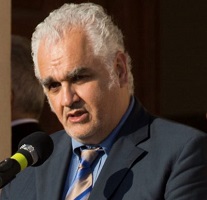 |
 |
| D. Athanasoulis, Dr., Aristotle University of Thessaloniki, Greece | A. Farnoux, Director, Ecole Francaise d’Athenes, France |
Abstract
Délos : un ensemble immobilier menacé par le changement climatique Par Demetrios Athanasoulis, Alexandre Farnoux et le comité franco-grec de Délos Résumé Explorée depuis 1873, l’île de Délos constitue aujourd’hui un des exemples les plus complets de l’architecture grecque antique, avec le sanctuaire d’Apollon, la ville et le port. Cet ensemble est menacé depuis quelques années par le changement climatique : des intempéries plus nombreuses avec de fortes pluies et des vents violents et l’augmentation du niveau de la mer causent des dégâts sur les vestiges. Le comité franco-grec créé en 2015 a entrepris un certain nombre d’opérations pour faire face à ces menaces nouvelles.
Presentation
Press image to see the presentation
13:20 - 13:40
“The floods of Mt. Olympus at Dion archaeological site”
D. Pandermalis, , President of the Acropolis Museum, Greece
“The floods of Mt. Olympus at Dion archaeological site”
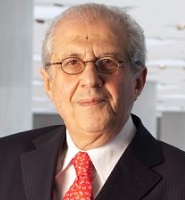
Abstract
-------
Presentation
Δ. ΠΑΝΤΕΡΜΑΛΗΣ: Ευχαριστώ πολύ κ. Πρόεδρε. Κύριε Υπουργέ, κυρία Γενική, αγαπητοί φίλοι, θα κλείσω με ένα πραγματικό παράδειγμα μιας απειλητικής καταστροφής από την οποία είχα εμπειρία προσωπικά ο ίδιος και η Γενική Γραμματέας του Υπουργείου Πολιτισμού.
Είχα το προνόμιο για πολλά χρόνια, περίπου 50 χρόνια, να κάνω αρχαιολογικές ανασκαφές στην περιοχή αυτή σε μια στενή λωρίδα γης, ανάμεσα στο ψηλότερο βουνό της Ελλάδας, τον Όλυμπο, και τη θάλασσα του Βορείου Αιγαίου.
Είναι μια περιοχή που φαίνεται από την αρχαιότητα είχε πάρα πολύ ενδιαφέρον κλιματικών αλλαγών, το οποίο όμως επιδεινώθηκε, για να θυμηθούμε λίγο τη μυθολογία, γιατί αρχαία Ελλάδα χωρίς μυθολογία δεν γίνεται, λίγα χιλιόμετρα πιο πέρα από το Δίον, νοτίως στα 8 χιλιόμετρα, έλεγαν οι αρχαίοι ότι υπήρχε μια πόλη, τα Λείβηθρα που ήταν ιερή πόλη του Ορφέα. Η πόλη αυτή ήταν χτισμένη στην όχθη ενός ξεροποτάμου. Κάποια στιγμή ήρθε ένας μάντης και τους είπε ξέρετε η πόλη σας θα καταστραφεί από ένα Sus. Sus είναι ο αγριόχοιρος.
Γέλασαν αυτοί και είπαν είναι δυνατόν ένα ζώο να καταστρέψει ολόκληρη πόλη; Αλλά Sus λεγόταν και ο ξεροπόταμος. Ένα βράδυ κατέβασε ο Όλυμπος πάρα πολλά νερά και εξαφανίστηκε η πόλη. Και τότε, λέει, καταστράφηκε και ο τάφος του Ορφέα και μεταφέρθηκε στην περιοχή του Δίου.
Έχουμε μια μεγάλη καταστροφή από πλημμύρα η οποία μαρτυρείται στους προϊστορικούς χρόνους. Βλέπετε εδώ πέρα τα νερά του Ολύμπου κατεβαίνουν από τα χιόνια τα οποία βρίσκονται πάνω και όλο το χρόνο μέσα στις χαράδρες γίνονται αυτές οι λιμνούλες, οι μικροί καταρράκτες και το νερό προχωρεί προς τα κάτω, αλλά κάποια στιγμή λίγο πιο πάνω από το χώρο που κάναμε ανασκαφές το νερό αυτό εξαφανίζεται μέσα στη γη.
Άλλο ένα γεωλογικό φαινόμενο το οποίο σχετίστηκε πάλι με τη μυθολογία. Το νερό αυτό μπαίνει μέσα στη γη και ξαναβγαίνει εκεί που κάνουμε τις ανασκαφές. Αναβλύζει, περπατάει υπόγεια και αναβλύζει. Οι αρχαίοι το έντυσαν με το μύθο του Ορφέα και είπαν ότι εκεί οι μαινόμενες γυναίκες της περιοχής, σκότωσαν τον Ορφέα επειδή ο Ορφέας με τη μουσική του μάγευε τους άντρες και αντί να κάνουν τις δουλειές που έπρεπε, βλέπετε πώς αναβλύζουν τα νερά, ακολουθούσαν τον Ορφέα.
Αυτό είναι το αίμα του Ορφέα το οποίο βγαίνει στον αρχαιολογικό χώρο του Δίου. Ο χώρος αυτός έχει μια ειδυλλιακή μορφή, πάρα πολύ βλάστηση και ασφαλώς τράβηξε το ενδιαφέρον των αρχαίων από πολύ νωρίς και για ένα άλλο λόγο που έχει σχέση με το κλίμα. Έχει πάρα πολλές βελανιδιές ψηλές οι οποίες τραβούν τους κεραυνούς.
Έπεφταν πάρα πολλοί κεραυνοί και είπαν εδώ πέρα ο Δίας, ο πατέρας των Θεών, σημαδεύει ότι πρέπει να κάνουμε το ιερό του. Και πράγματι εδώ έγινε το μεγαλύτερο ιερό του Διός στη Βόρεια Ελλάδα.
Αυτός ο ειδυλλιακός χώρος μερικές φορές υφίσταται το αποτέλεσμα της κλιματικής αλλαγής, βλέπετε παντού τα νερά και νεροφίδες. Αυτό είναι το ιερό της Ίσιδας, όπου αναβλύζουν νερά. Αυτή είναι μια κατάσταση ηρεμίας, θα λέγαμε και όταν αρχίζουν οι ταραχές του περιβάλλοντος, της φύσης, θα δείτε τι συμβαίνει εδώ πέρα.
Εδώ είναι οι κατασκευές που έχουμε μέσα στον αρχαιολογικό χώρο για να μπορεί κανείς να κάνει εύκολα τον περίπατο. Ξαφνικά ο Όλυμπος σκοτεινιάζει και αρχίζει να κατεβαίνει νερό από τον Όλυμπο, θολώνει το ποτάμι που είναι δίπλα και στη συνέχεια οι κολώνες τις οποίες βλέπετε να στέκονται όρθιες, αυτές εκεί στο βάθος, γεμίζουν νερό και βλέπει κανείς μόνο το επάνω μέρος με τα κιονόκρανα.
Κατεβαίνει δηλαδή μια τεράστια ποσότητα νερού η οποία παραμένει εκεί πέρα για αρκετές ώρες και θα δείτε αμέσως μετά το τράβηγμα των νερών, το αποτέλεσμα.
Έχει κανείς την αίσθηση ότι είναι μετά από μια μεγάλη μάχη. Είναι πεδίο μάχης. Κατακαλύπτεται ένα ανάγλυφο το οποίο το είχαμε στη θέση του, ένα αντίγραφο. Αυτή είναι η εικόνα του ιερού. Βέβαια πλημμύρες είχαν συμβεί και παλαιότερα. Δεν είναι η πρώτη φορά. Με τη βοήθεια των τοπικών αρχών και του Υπουργείου Πολιτισμού κάναμε αποχετευτικά κανάλια για να φεύγουν. Η βροχή όμως που ήταν και η καταιγίδα πριν από τρία χρόνια, πραγματικά γέμισε τον αρχαιολογικό χώρο με λάσπη και ευχαριστώ και από τη θέση αυτή τη Γενική Γραμματέα που μας έστειλε άμεσα μια πίστωση για να αρχίσουμε τον καθαρισμό.
Ένας δεύτερος τομέας, το ιερό του Διός υψίστου μέσα στον αρχαιολογικό χώρο, το οποίο επίσης κατακλύστηκε από λάσπη, χώματα, πέτρες και άμμο. Το βλέπετε εδώ πέρα σε μια ήρεμη κατάσταση.
Και η εικόνα του ίδιου ιερού μετά τη βροχή.
Επομένως δεν είναι απλώς να συντηρήσουμε ορισμένους τοίχους. Εδώ πέρα πρόκειται για τεράστια επέμβαση, βίαιη επέμβαση της φύσης. Δείτε εδώ πέρα το θέατρο. Η ορχήστρα του θεάτρου την οποία θα τη δείτε σε λίγο σαν μια λίμνη. Και ακόμα περισσότερο και μέσα στην αρχαία πόλη. Εδώ είναι η περιοχή των μεγάλων σπιτιών της πόλης, βρήκαμε το ψηφιδωτό του Διονύσου το οποίο είναι περίπου στο κέντρο ενός μεγάλου σπιτιού. Ευτυχώς πριν από πέντε χρόνια, αποφασίσαμε να το αποξηλώσουμε και να το μεταφέρουμε στο μουσείο για να σωθεί. Είναι ένα καταπληκτικό έργο τέχνης 200 τ.μ. αριστούργημα της αρχαίας ψηφοθετικής. Η κατάσταση μετά τη βροχή. Ευτυχώς που το βγάλαμε και το σώσαμε.
Και η υποδομή. Η μεγάλη ζημιά επίσης έγινε στις υποδομές. Αυτές είναι οι γέφυρες, τα μικρά φράγματα, οι διευθετήσεις που είχαμε των υπόγειων νερών και των νερών που ανεβαίνουν στην επιφάνεια. Όλα αυτά καταστράφηκαν εξαιτίας αυτής της υπερβολικής ποσότητας νερού που κατέκλυσε τον αρχαιολογικό χώρο.
Και από την πλευρά του αρχαίου τείχους, αυτή είναι η επίχωση που κατέβασε μέσα σε 24 ώρες το ποτάμι. Βλέπετε τη γέφυρα. Περίπου 4 μέτρα χαλίκι γέμισε αυτή την τάφρο η οποία ήταν η αποχετευτική τάφρος. Έγινε ένα έργο καθαρισμού, αλλά είμαστε ακόμα στο επίπεδο να επαναφέρουμε τον αρχαιολογικό χώρο σε αυτή την ειδυλλιακή μορφή.
Ωστόσο μέσα μας υπάρχει ακόμα ο φόβος ποια θα είναι η επόμενη απειλή της φύσης εξαιτίας της αλλαγής του περιβάλλοντος και της κλιματικής αλλαγής. Σας ευχαριστώ πολύ.
13:40
Adoption of the concluding document / Concept Note
Light Luncheon
Speakers via Teleconference:
“Adoption of the concluding document”

“Amplification - small changes in climate that have large impacts on heritage”

Abstract
Amplification - small changes in climate that have large impacts on heritage
Peter Brimblecombe, School of Energy and Environment, City University of Hong Kong
In the last 10 years our understanding of climate change has improved through the availability of higher resolution climate models, both in the temporal and spatial domain. Temperature is generally well predicted as is absolute humidity, but there are greater difficulties with rainfall which may be strongly influenced by storm tracks and related synoptic issues. Nevertheless there is now a better understanding of the way in which small changes in climate may cause large changes in the rate of damage to heritage materials and wider effects of the appreciation of cultural sites. Amplification can occur though changes in phase or the mediation of biological processes. In this presentation output from climate models and recent meteorological observations will be compared with evidence of broader environmental change, rates of damage and shifts in seasonality. These which provide hints that some changes in the impact of shifts in climate on heritage can already be observed.
Press Conference
Theme 2.
Tools and mechanisms
Theme - Session Title - SubTheme - HALL B
Coordinator Name
Overview
Theme - Session Title - SubTheme - HALL B
Coordinator Name
Overview
Theme - Session Title - SubTheme - HALL B
Coordinator Name
Overview
Theme - Session Title - SubTheme - HALL B
Coordinator Name
Overview
Theme - Session Title - SubTheme - HALL B
Coordinator Name
Overview
Theme - Session Title - SubTheme - HALL B
Coordinator Name
Overview
09:00 - 09:30
Registration
09:30 - 10:00
Welcome Addresses
Welcome Addresses
- Mr. G. Katrougalos, Minister of Foreign Affairs
- Mr. C. Fotakis, Alternate Minister of Education, Research & Religion
- Mr. S. Famelos, Alternate Minister of Environment & Energy
10:00 - 10:20
“Manmade climate change and its impacts on cultural heritage”
C. Zerefos,, Professor, Head, Research Center for Climatology, Academy of Athens, Greece
“Manmade climate change and its impacts on cultural heritage”

Abstract
Cultural heritage is extremely vulnerable to natural phenomena and manmade interventions to our environment. The Mediterranean as the cradle of monuments and ideas of worldwide interest has been identified as the hot spot in a manmade destabilized climate. Exposure to changes is extreme events such as gale force winds, floods, landslides and sea level rise on top of a threatened by seismologically unstable soils threaten the Mediterranean with emphasis on the eastern part of this closed sea. Global warming has effects on ecosystems and is threatening agriculture and heritage areas in the long shorelines in Greece, Italy and elsewhere caused by intrusion of salt water in the groundwater table particularly near the shoreline. Cultural heritage may influence also religious culture in view of the expected large changes not only in air temperatures but also in humidity and comfort. Cultural heritage is more than ever threatened by the synergistic effects of global warming, forest fires and seismicity in large parts of the Globe. Examples of observed and expected changes will be discussed.
10:20 - 10:40
“Historical Climatology as an important discipline to study past climate, extremes and natural hazards and their impact on society and cultural heritage”
J. Luterbacher, Professor & Chair for Climatology, Climate Dynamics and Climate Change, Justus-Liebig University of Giessen, Germany
“Historical Climatology as an important discipline to study past climate, extremes and natural hazards and their impact on society and cultural heritage”

Luterbacher, J.,
Professor & Chair for Climatology, Climate Dynamics and Climate Change, Justus-Liebig University, University of Giessen, Germany
Abstract
Historical Climatology as an important discipline to study past climate, extremes and natural hazards and their impact on society and cultural heritage
Historical climatology is the use of documentary and written evidence to study historical changes in climate, extremes and their effect on human history and development. Historical Climatology follows two main goals:
- reconstructing temporal and spatial patterns of weather and climate including natural disasters and hazards (floods, storms, drought, heatwaves, earthquakes, fires, etc.) for the period prior to national meteorological networks,
- investigating the vulnerability of past societies and economies to climate variations, climate extremes and natural disasters.
Historical Climatology can contribute to the current debate on the long-term impacts of adverse climate conditions, extremes and natural hazards from a historical point of view. For instance, the study of historical flooding with respect to meteorological causes, frequency, severity and human impacts and damages on cultural heritage and historical monuments provides important information in developing future flood risk management strategies.
The talk presents the tools used by historical climatologist and shows different examples of past natural disasters and extremes from Europe and the Mediterranean and how they have affected human affairs and led to material damage.
10:40 - 11:00
“Challenges of regional climate change over the Mediterranean - The added value from Regional Climate Models (RCMs)”
P. Zanis, Professor, Department of Meteorology and Climatology, Aristotle University of Thessaloniki, Greece
“Challenges of regional climate change over the Mediterranean - The added value from Regional Climate Models (RCMs)”

Zanis, P.,
Professor, Department of Meteorology and Climatology, Aristotle University of Thessaloniki, Greece
Abstract
Regional climate models (RCMs) are well established tools for the application of dynamical downscaling methods to enhance the regional information provided by Global Climate Models (GCMs) or by the large scale reanalysis. The added value of using RCMs is their ability to simulate atmospheric processes at a wide range of spatial and temporal scales because they represent topographical features in more detail due to their higher resolution. The Mediterranean region is characterized by complex mountain topographies, coastlines, small islands and peninsulas and hence downscaling to higher resolution is necessary for regional climate change impact studies. Reliable and user friendly open access of ensembles of future climate change data from high resolution RCM projections are essential to support decision makers, stakeholders, intermediary users and end-users for climate change impacts, mitigation and adaptation. The need of user friendly interactive web application tools for data extraction from RCMs is discussed.
11:00 - 11:30
Coffee Break
11:30 - 11:50
“Climate Change and Underwater Cultural Heritage in the Mediterranean Scenery”
V. Argyropoulou, , Professor, Uniwa, Greece
“Climate Change and Underwater Cultural Heritage in the Mediterranean Scenery”

Abstract
Research of Climate Change (CC) impacts on Cultural Heritage (CH) has mostly focused on land CH or CH located along coastlines, with little concern being placed on Underwater Cultural Heritage (UCH). However, it is said that there is more history underwater than in all the museums of the world combined, especially in the Mediterranean Region. The geographical particularities of this region, and the commercial and cultural interaction through Mediterranean sea-roads have strongly affected maritime traditions that go back at least 5,000 years. These traditions can, among others, be identified in sunken shipwrecks and their contents located at the sea bottom, which are unique in the sense that they encapsulate a single moment in time, and are comparable to rare land examples such as Pompeii or Thera. CC impacts on the sea, i.e. warming of oceans, changing of its chemical composition (acidity and salinity), shifting of currents’ pattern etc., places UCH at yet unidentified risks. The presentation will attempt to explore potential CC-related risks of UCH in the Mediterranean scenery, while highlighting the need for baseline research of UCH made from different materials in order to better assess these impacts and make more informed and sustainable management plans for UCH from different periods.
Presentation
Press image to see the presentation
11:50 - 12:10
“From Deduction to Prediction! Examining the Impact of Climate Change on Cultural Heritage”
R. Jigyasu,, Programme Officer ICCROM Athar regional Conservation Center in Sharjah, India
“From Deduction to Prediction! Examining the Impact of Climate Change on Cultural Heritage”

Abstract
From Deduction to Prediction! Examining the Impact of Climate Change on Cultural Heritage
By Dr. Rohit Jigyasu, Programme Officer, ICCROM
Vice President, ICOMOS International
Climate change is increasing the number of disasters and their devastating impacts. From 1988 to 2007, 76% of all disaster events were hydrological, meteorological or climatological in nature. The likelihood of increased weather extremes in future therefore gives great concern that the number or scale of weather-related disasters will also increase. Climate change related disasters have wider physical, environmental, social and economic impacts. These directly or indirectly also impacts cultural heritage of various types ranging from monuments to historic towns and cultural landscapes. As a result, various tangible and intangible attributes of Cultural heritage would be increasingly affected leading to loss of values. However there is disconnect between various initiatives undertaken for climate change adaptation, disaster risk reduction and heritage conservation at policy, planning and institutional levels. This would necessitate bringing together agendas for development, disaster risk reduction and climate change and variability and focusing on mitigation and preparedness. Also cultural heritage concerns should be mainstreamed into disaster risk reduction and climate change adaptation at multiple levels. The paper will detail out impacts of cultural heritage due to climate change and suggest ways of integrating climate change and disaster risk reduction agenda in heritage management policies and practices.
12:10 - 12:30
“How to use climate models and building simulation to assess the impact of climate change on historic buildings and art collections”
J. Leissner,., Dr., Scientific Representative, “Fraunhofer”, Germany
“How to use climate models and building simulation to assess the impact of climate change on historic buildings and art collections”

Abstract
Climate change is one of the most important global challenges of our time. Although many studies have been conducted to explore its impact on e.g. biodiversity and agriculture, little is known as to whether and to what extent climate change influences cultural heritage assets. Against this background, the EU-funded "Climate for Culture" project (2009-2014) has investigated the potential impact of changing climate conditions on historic buildings and the collections they contain as well as on the future energy demand in Europe and the Mediterranean. Art objects are often very sensitive to variations in humidity and temperature. The main innovation was to use a combination of simulation and modelling tools to predict more accurately the influence of changing outdoor climate on the indoor and microclimate in historic buildings until 2100. Further, future energy demand for climatisation of historic buildings was calculated. By using an automated procedure an assessment of the damage potential in various climate zones was performed. In order to assess the damage potential of these future climatic conditions, a set of damage functions has been applied to four categories of objects (sculptures, panel paintings, furniture and paper manuscripts). Furthermore, sensitive glass sensors developed within the EU project AMECP (1993-1996) have been used in “Climate for Culture” to assess the corrosive damage potential of current outdoor and indoor climates at the case study sites. Glass sensors act in an integrating way as dosimeters, i.e. they monitor the combined corrosive effects (in the present case, of temperature and humidity) on a longer time scale as well as daily fluctuations.
Presentation
Press image to see the presentation
12:30 - 13:30
Lunch Break
13:30 - 13:50
“Manmade activities and their impact on monuments: the Acropolis case”
M. Vlazaki Andreadaki, , General Secretary of Culture, Greece
“Manmade activities and their impact on monuments: the Acropolis case”

Abstract
Anthropogenic activities and their impact on monuments: The case of the Acropolis.
The phenomenon of climate change, the occurrence of extreme weather phenomena and the degradation of the environment, especially in the urban centers, also affects the monuments which have stood for centuries. Indeed, many claim that the damage suffered in recent decades far exceeds the damage of the past. Our speech attempts to illustrate the data as well as measures to address the adverse effects of human activities on monuments, with particular reference to the emblematic monuments of the Acropolis.
Press image to see the presentation
13:50 - 14:10
“Notable impacts of climate change on Armenian historical monuments of Architecture”
D. Kertmenjian, , Doctor of Architecture, Leading Researcher at the Department of Diaspora's Armenian Art and International Relations of the Institute of Arts of the National Academy of Sciences of RA, Armenia
“Notable impacts of climate change on Armenian historical monuments of Architecture”

Abstract
Notable is the effect of climate changes on preservation of historical monuments in last decades. That so very urgent is the update of documentary information of the case. The State of the Art are the damages and deterioration noticed because of new natural-climatic conditions. The main problem of the research is the fixation and stabilization of the changes occurred. The objectives include: 1. The definition of the climatic impacts, 2. Beside soil media reactions concentration on of “ Mitis” type layered masonry technique in Armenia and its notable behavior towards new changes, 3. Hasty Diagnosis and mapping on three case studies carried out. Methodology is the qualitative study and comparative analysis of the damages in behalf of back weathering, dilapidation and condensation or desalination aspects noticed on newly treated parts.
14:10 - 14:30
“Ecosystem based approach for climate adaptation in Kune Vain Lagoon, Lezha, Albania”
O. Çuçi, , Deputy Minister of Ministry of Tourism and Environment of Albania
“Ecosystem based approach for climate adaptation in Kune Vain Lagoon, Lezha, Albania”

Abstract
Lezha region is situated on the coastal zone of Adriatic Sea, a cross road to north of Albania. It is rich in historical sites and cultural heritage with castles and sites from medieval age. Due to climate changes and alteration of the landscape by human settlements and tourism development, it is facing frequently flood events due to torrential storms. Furthermore, the nearby Kune-Vain lagoon, a nature touristic site, very rich on birds and other animal habits, is threatened by sea level raise and habitat loss. A number of adaptive measures and interventions are made based on ecosystem services such as reforestation, dune restorations, maintain the water communication flow with the sea, as well as community involvement and education.
Press image to see the presentation
14:30 - 14:50
“The role of climate in Museum Buildings. Albanian Case Studies”
E. Bushati, , Vice Dean of Faculty of Architecture and Urbanism, Albania
“The role of climate in Museum Buildings. Albanian Case Studies”
Abstract
Museums are housed in buildings designed for museum but often they are housed in buildings which are not designed and build for this purpose. These two main museum building typologies can fulfill different indoor climates for artefacts preservation. Seeing in this complexion, the building is a buffer volume which plays the main role in mitigating the external climate. Building design, construction and the building technologies affects building performance and as a result the indoor climate. For the preservation of the artefacts in a museum the indoor climate is often restricted to a narrow interval for temperature, but most of all for relative humidity. These standards for temperature and relative humidity, however, does not fit well in some museum buildings. For this reason, today’s museum standards for artefacts preservation must be verified and evaluated based on real site measurements. The monitored parameters should be interpreted starting initially from the building design, building materials and building technology.
For some typical Albanian museums case studies have been done to show how the physical building effects the museum climate. Three well known Albanian museums are selected to be examined; The National Historic Museum, the Archeological Museum of Tirana and the Iconographic Museum “Onufri” of Berat. The three examined museum buildings represent different museum building typologies as well as different construction technologies. The National Historic Museum is a building designed to be a museum and is one of the most representative buildings of this typologies. It is constructed in 1981 and the construction technologies are considered as advanced for the period. The Archeological Museum and the Iconographic Museum “Onufri” represent the museum buildings that are not build for this purpose but are used as museum buildings. The Archeological Museum is housed in a building designed by Italian architect G.Bosio in 1939 embodying the construction technologies of the period when it was built. The Iconographic Museum “Onufri” is housed in the Saint Mary church that is the most representative church of Albanian post-Byzantine architecture. It is constructed in 1797.
Buildings are analyzed in a methodological way. The process of selecting buildings is based on well-defined criteria. The monitored buildings should represent different museum typologies, were built in different periods, were identified as problematic during the site visits and also is taken into consideration the cultural, social and economic importance of the selected buildings in the Albanian museums network.
For a measurement period, at least one year, are done records of Temperature and Relative Humidity in different indoor environments of the three mentioned above buildings. The measurements are done in a narrow frequency (each 15 minutes) with electronic data loggers. The values and the results compared between the three buildings. Analyses of thermo hygrometric parameters (T and LR) showed that there is a contrast among indoor climates of these buildings. Each building appears with its own indoor climatic characteristics, depending on the type of building, construction characteristics and the level of building degradation. The study interprets the data after it is analyzed the construction technology for each building and proposes the strategy to improve the preservation conditions.
Key words: Museum building, building technology, temperature, relative humidity, preservation
14:50 - 15:20
Coffee Break
15:20 - 15:40
“Sea-level rise impacts on the Mediterranean UNESCO World Heritage Sites”
A. Vafeidis, , Prof. Dr, Kiel University, Group Leader, Coastal Risks and Sea-Level Rise Research Group, Germany
“Sea-level rise impacts on the Mediterranean UNESCO World Heritage Sites”

Abstract
Athanasios T. Vafeidis & Lena Reimann
Climate-induced sea-level rise is exacerbating the risk of coastal hazards, such as flooding and erosion, directly threatening UNESCO World Heritage sites (WHS) located in coastal areas. The Mediterranean region has a particularly high concentration of cultural WHS in coastal locations as several ancient civilisations have developed in the region. This study presents an index-based approach that allows for assessing and forecasting WHS at risk from coastal flooding and erosion in the Mediterranean under four sea-level rise scenarios, until 2100. We show that, already today, 37 out of 49 cultural WHS located in low-lying coastal areas of the Mediterranean are at risk from a 100-year flood and 42 from coastal erosion. Until 2100, flood risk may increase by 50% and erosion risk by 13% across the region, with considerably higher increases at individual sites. Most affected countries include Italy, Croatia, Greece and Tunisia. These results provide a first-order assessment of where adaptation is most urgently required. Our findings can be used by policymakers to steer detailed research at local-scale, which can provide the necessary information for devising innovative adaptation strategies particularly suited to the characteristics of each specific WHS.
Presentation
Press image to see the presentation
15:40 - 16:00
“Climate Change versus Archaeological Sites and Monuments: an unequal battle”
P. Veleni-Adam, , Dr, Archeologist, Director of the General Directorate of Antiquities and Cultural Heritage, Greece
“Climate Change versus Archaeological Sites and Monuments: an unequal battle”

Abstract
The climate change is always a major concern because it can cause natural disasters and serious damage to World Cultural Heritage. This is particularly so today because many natural disasters are brought about, or increased, by climate change throughout the world. The extreme weather conditions cause drought, fires, flooding from rivers and lakes and affect the natural and cultural environments in Greece.
Reducing and managing the risk of natural disasters are significant challenges before the world community. Climate change and natural disasters are the consequences of uncontrolled human activity and poor environmental management, bringing damage to World Heritage monuments.
Presentation
Press image to see the presentation
16:00 - 16:20
“Impact of natural disasters on cultural sites – Lessons from Greece”
E. Lekkas,, Professor, Faculty of Geology and Geoenviroment, National and Kapodistrian University of Athens, President, Earthquake Planning and Protection Organization, Greece
“Impact of natural disasters on cultural sites – Lessons from Greece”

Abstract
Greece and the broader Easter Mediterranean have very dynamic geomorphological, environmental and geodynamic regime, that provided a very unique landscape to its inhabitants since prehistoric times. The scenic landforms that were shaped by the constant natural processes and the abundance of hazardous phenomena of the region, such as floods, earthquakes, volcanos, were to a degree part to the ancient societies and their heritage. Their symbiosis, one that lasts for thousands of years, has transferred to our modern societies the responsibility to protect the remnants of this heritage. In the Greek landscape, natural disasters are looming over numerous invaluable cultural sites. Using modern tools we are in the process of understanding the natural risks that threaten cultural sites, especially from new challenges arising from climate change and the associated the intensification of hydro-meteorological and climate-related hazards.
16:20 - 16:40
“The Socio-Economic Value of Culture: Estimating of Climate Change Effects”
P. Koundouri, , University of Economics & Business, Greece
“The Socio-Economic Value of Culture: Estimating of Climate Change Effects”

Abstract
In October 2018 the IPCC special report on “Global Warming of 1.5 ºC” warned that there are only a dozen years for global warming to be kept to a maximum of 1.5C, beyond which, even half a degree will significantly worsen the risks of drought, floods, extreme heat and poverty for hundreds of millions of people around the globe. Urgent and unprecedented changes are needed to reach the target. Such a transition can be achieved by developing structured and methodologically sound approaches to recognizing, demonstrating and capturing the Total Economic Value of resources.
Although research on the economic and social effects of climate change on cultural resources and services, is not extensive, my contribution will focus on the methods available to estimate and monetize these effects and understand the social value of conserving culture. Central to my speech will be the concept of the ‘total economic value' and in particular the value humans derive from cultural resources, within a framework of climate change, uncertainty and ambiguity. The estimation of this value is crucial for understanding how much it should be invested in order to conserve cultural goods and services, as well as develop efficient policies for sustainable cultural management.
The speech will present my research on refining theoretical models and empirical methods used in the field of economics, towards: (a) better understanding of the concept and determinants of the total economic
value of cultural goods and services, (b) more accurate modelling of this value, (c) more robust estimation of this value, (d) more efficient integration of this value in interdisciplinary cultural management and policy-making, while (e) incentivizing the development of technological and social innovations that integrate this value and accelerate these innovations in the market.
Presentation
Press image to see the presentation
20:30
Dinner for the Speakers at the Acropolis Museum
(by invitation only)
Before dinner, guests will hear from Professor Th. P.Tassios, who will address the topic: “Views of the Ancient Greeks on the environment”
“Views of the Ancient Greeks on the environment”

Abstract
In Greek Mythology, several plants and animals were considered sacred and were protected. The Presocratic philosophers, who taught that we all belong to a “Cosmic Ensemble”, paved the way for the respect to Nature. During the classical period, Plato himself was very much concerned with the damaging effects of mountain deforestation on the distribution of rainwater that would, as a consequence, flow rapidly to the sea and be wasted. Aristotle supported the idea of a “common substance” of all living species. He also predicted, in his Meteorologika, the risk of some humid regions becoming arid. Finally, it is remarkable that, thanks to their correct heliocentric beliefs and their knowledge of the Earth’s sphaerical form, the Greeks undermined the anthropocentric view of a flat Earth, centre of the universe, offered by the Gods to the humans as a gift to be exploited unconditionally.
Theme 3.
Best practices and policy responses
09:00 - 09:30
Registration
09:30 - 10:00
Welcome Addresses
Welcome Addresses
- Mr. G. Katrougalos, Minister of Foreign Affairs
- Mr. C. Fotakis, Alternate Minister of Education, Research & Religion
- Mr. S. Famelos, Alternate Minister of Environment & Energy
10:00 - 10:20
“Manmade climate change and its impacts on cultural heritage”
C. Zerefos,, Professor, Head, Research Center for Climatology, Academy of Athens, Greece
“Manmade climate change and its impacts on cultural heritage”

Abstract
Cultural heritage is extremely vulnerable to natural phenomena and manmade interventions to our environment. The Mediterranean as the cradle of monuments and ideas of worldwide interest has been identified as the hot spot in a manmade destabilized climate. Exposure to changes is extreme events such as gale force winds, floods, landslides and sea level rise on top of a threatened by seismologically unstable soils threaten the Mediterranean with emphasis on the eastern part of this closed sea. Global warming has effects on ecosystems and is threatening agriculture and heritage areas in the long shorelines in Greece, Italy and elsewhere caused by intrusion of salt water in the groundwater table particularly near the shoreline. Cultural heritage may influence also religious culture in view of the expected large changes not only in air temperatures but also in humidity and comfort. Cultural heritage is more than ever threatened by the synergistic effects of global warming, forest fires and seismicity in large parts of the Globe. Examples of observed and expected changes will be discussed.
10:20 - 10:40
“Historical Climatology as an important discipline to study past climate, extremes and natural hazards and their impact on society and cultural heritage”
J. Luterbacher, Professor & Chair for Climatology, Climate Dynamics and Climate Change, Justus-Liebig University of Giessen, Germany
“Historical Climatology as an important discipline to study past climate, extremes and natural hazards and their impact on society and cultural heritage”

Luterbacher, J.,
Professor & Chair for Climatology, Climate Dynamics and Climate Change, Justus-Liebig University, University of Giessen, Germany
Abstract
Historical Climatology as an important discipline to study past climate, extremes and natural hazards and their impact on society and cultural heritage
Historical climatology is the use of documentary and written evidence to study historical changes in climate, extremes and their effect on human history and development. Historical Climatology follows two main goals:
- reconstructing temporal and spatial patterns of weather and climate including natural disasters and hazards (floods, storms, drought, heatwaves, earthquakes, fires, etc.) for the period prior to national meteorological networks,
- investigating the vulnerability of past societies and economies to climate variations, climate extremes and natural disasters.
Historical Climatology can contribute to the current debate on the long-term impacts of adverse climate conditions, extremes and natural hazards from a historical point of view. For instance, the study of historical flooding with respect to meteorological causes, frequency, severity and human impacts and damages on cultural heritage and historical monuments provides important information in developing future flood risk management strategies.
The talk presents the tools used by historical climatologist and shows different examples of past natural disasters and extremes from Europe and the Mediterranean and how they have affected human affairs and led to material damage.
10:40 - 11:00
“Challenges of regional climate change over the Mediterranean - The added value from Regional Climate Models (RCMs)”
P. Zanis, Professor, Department of Meteorology and Climatology, Aristotle University of Thessaloniki, Greece
“Challenges of regional climate change over the Mediterranean - The added value from Regional Climate Models (RCMs)”

Zanis, P.,
Professor, Department of Meteorology and Climatology, Aristotle University of Thessaloniki, Greece
Abstract
Regional climate models (RCMs) are well established tools for the application of dynamical downscaling methods to enhance the regional information provided by Global Climate Models (GCMs) or by the large scale reanalysis. The added value of using RCMs is their ability to simulate atmospheric processes at a wide range of spatial and temporal scales because they represent topographical features in more detail due to their higher resolution. The Mediterranean region is characterized by complex mountain topographies, coastlines, small islands and peninsulas and hence downscaling to higher resolution is necessary for regional climate change impact studies. Reliable and user friendly open access of ensembles of future climate change data from high resolution RCM projections are essential to support decision makers, stakeholders, intermediary users and end-users for climate change impacts, mitigation and adaptation. The need of user friendly interactive web application tools for data extraction from RCMs is discussed.
11:00 - 11:30
Coffee Break
11:30 - 11:50
“Climate Change and Underwater Cultural Heritage in the Mediterranean Scenery”
V. Argyropoulou, , Professor, Uniwa, Greece
“Climate Change and Underwater Cultural Heritage in the Mediterranean Scenery”

Abstract
Research of Climate Change (CC) impacts on Cultural Heritage (CH) has mostly focused on land CH or CH located along coastlines, with little concern being placed on Underwater Cultural Heritage (UCH). However, it is said that there is more history underwater than in all the museums of the world combined, especially in the Mediterranean Region. The geographical particularities of this region, and the commercial and cultural interaction through Mediterranean sea-roads have strongly affected maritime traditions that go back at least 5,000 years. These traditions can, among others, be identified in sunken shipwrecks and their contents located at the sea bottom, which are unique in the sense that they encapsulate a single moment in time, and are comparable to rare land examples such as Pompeii or Thera. CC impacts on the sea, i.e. warming of oceans, changing of its chemical composition (acidity and salinity), shifting of currents’ pattern etc., places UCH at yet unidentified risks. The presentation will attempt to explore potential CC-related risks of UCH in the Mediterranean scenery, while highlighting the need for baseline research of UCH made from different materials in order to better assess these impacts and make more informed and sustainable management plans for UCH from different periods.
Presentation
Press image to see the presentation
11:50 - 12:10
“From Deduction to Prediction! Examining the Impact of Climate Change on Cultural Heritage”
R. Jigyasu,, Programme Officer ICCROM Athar regional Conservation Center in Sharjah, India
“From Deduction to Prediction! Examining the Impact of Climate Change on Cultural Heritage”

Abstract
From Deduction to Prediction! Examining the Impact of Climate Change on Cultural Heritage
By Dr. Rohit Jigyasu, Programme Officer, ICCROM
Vice President, ICOMOS International
Climate change is increasing the number of disasters and their devastating impacts. From 1988 to 2007, 76% of all disaster events were hydrological, meteorological or climatological in nature. The likelihood of increased weather extremes in future therefore gives great concern that the number or scale of weather-related disasters will also increase. Climate change related disasters have wider physical, environmental, social and economic impacts. These directly or indirectly also impacts cultural heritage of various types ranging from monuments to historic towns and cultural landscapes. As a result, various tangible and intangible attributes of Cultural heritage would be increasingly affected leading to loss of values. However there is disconnect between various initiatives undertaken for climate change adaptation, disaster risk reduction and heritage conservation at policy, planning and institutional levels. This would necessitate bringing together agendas for development, disaster risk reduction and climate change and variability and focusing on mitigation and preparedness. Also cultural heritage concerns should be mainstreamed into disaster risk reduction and climate change adaptation at multiple levels. The paper will detail out impacts of cultural heritage due to climate change and suggest ways of integrating climate change and disaster risk reduction agenda in heritage management policies and practices.
12:10 - 12:30
“How to use climate models and building simulation to assess the impact of climate change on historic buildings and art collections”
J. Leissner,., Dr., Scientific Representative, “Fraunhofer”, Germany
“How to use climate models and building simulation to assess the impact of climate change on historic buildings and art collections”

Abstract
Climate change is one of the most important global challenges of our time. Although many studies have been conducted to explore its impact on e.g. biodiversity and agriculture, little is known as to whether and to what extent climate change influences cultural heritage assets. Against this background, the EU-funded "Climate for Culture" project (2009-2014) has investigated the potential impact of changing climate conditions on historic buildings and the collections they contain as well as on the future energy demand in Europe and the Mediterranean. Art objects are often very sensitive to variations in humidity and temperature. The main innovation was to use a combination of simulation and modelling tools to predict more accurately the influence of changing outdoor climate on the indoor and microclimate in historic buildings until 2100. Further, future energy demand for climatisation of historic buildings was calculated. By using an automated procedure an assessment of the damage potential in various climate zones was performed. In order to assess the damage potential of these future climatic conditions, a set of damage functions has been applied to four categories of objects (sculptures, panel paintings, furniture and paper manuscripts). Furthermore, sensitive glass sensors developed within the EU project AMECP (1993-1996) have been used in “Climate for Culture” to assess the corrosive damage potential of current outdoor and indoor climates at the case study sites. Glass sensors act in an integrating way as dosimeters, i.e. they monitor the combined corrosive effects (in the present case, of temperature and humidity) on a longer time scale as well as daily fluctuations.
Presentation
Press image to see the presentation
12:30 - 13:30
Lunch Break
13:30 - 13:50
“Manmade activities and their impact on monuments: the Acropolis case”
M. Vlazaki Andreadaki, , General Secretary of Culture, Greece
“Manmade activities and their impact on monuments: the Acropolis case”

Abstract
Anthropogenic activities and their impact on monuments: The case of the Acropolis.
The phenomenon of climate change, the occurrence of extreme weather phenomena and the degradation of the environment, especially in the urban centers, also affects the monuments which have stood for centuries. Indeed, many claim that the damage suffered in recent decades far exceeds the damage of the past. Our speech attempts to illustrate the data as well as measures to address the adverse effects of human activities on monuments, with particular reference to the emblematic monuments of the Acropolis.
Press image to see the presentation
13:50 - 14:10
“Notable impacts of climate change on Armenian historical monuments of Architecture”
D. Kertmenjian, , Doctor of Architecture, Leading Researcher at the Department of Diaspora's Armenian Art and International Relations of the Institute of Arts of the National Academy of Sciences of RA, Armenia
“Notable impacts of climate change on Armenian historical monuments of Architecture”

Abstract
Notable is the effect of climate changes on preservation of historical monuments in last decades. That so very urgent is the update of documentary information of the case. The State of the Art are the damages and deterioration noticed because of new natural-climatic conditions. The main problem of the research is the fixation and stabilization of the changes occurred. The objectives include: 1. The definition of the climatic impacts, 2. Beside soil media reactions concentration on of “ Mitis” type layered masonry technique in Armenia and its notable behavior towards new changes, 3. Hasty Diagnosis and mapping on three case studies carried out. Methodology is the qualitative study and comparative analysis of the damages in behalf of back weathering, dilapidation and condensation or desalination aspects noticed on newly treated parts.
14:10 - 14:30
“Ecosystem based approach for climate adaptation in Kune Vain Lagoon, Lezha, Albania”
O. Çuçi, , Deputy Minister of Ministry of Tourism and Environment of Albania
“Ecosystem based approach for climate adaptation in Kune Vain Lagoon, Lezha, Albania”

Abstract
Lezha region is situated on the coastal zone of Adriatic Sea, a cross road to north of Albania. It is rich in historical sites and cultural heritage with castles and sites from medieval age. Due to climate changes and alteration of the landscape by human settlements and tourism development, it is facing frequently flood events due to torrential storms. Furthermore, the nearby Kune-Vain lagoon, a nature touristic site, very rich on birds and other animal habits, is threatened by sea level raise and habitat loss. A number of adaptive measures and interventions are made based on ecosystem services such as reforestation, dune restorations, maintain the water communication flow with the sea, as well as community involvement and education.
Press image to see the presentation
14:30 - 14:50
“The role of climate in Museum Buildings. Albanian Case Studies”
E. Bushati, , Vice Dean of Faculty of Architecture and Urbanism, Albania
“The role of climate in Museum Buildings. Albanian Case Studies”
Abstract
Museums are housed in buildings designed for museum but often they are housed in buildings which are not designed and build for this purpose. These two main museum building typologies can fulfill different indoor climates for artefacts preservation. Seeing in this complexion, the building is a buffer volume which plays the main role in mitigating the external climate. Building design, construction and the building technologies affects building performance and as a result the indoor climate. For the preservation of the artefacts in a museum the indoor climate is often restricted to a narrow interval for temperature, but most of all for relative humidity. These standards for temperature and relative humidity, however, does not fit well in some museum buildings. For this reason, today’s museum standards for artefacts preservation must be verified and evaluated based on real site measurements. The monitored parameters should be interpreted starting initially from the building design, building materials and building technology.
For some typical Albanian museums case studies have been done to show how the physical building effects the museum climate. Three well known Albanian museums are selected to be examined; The National Historic Museum, the Archeological Museum of Tirana and the Iconographic Museum “Onufri” of Berat. The three examined museum buildings represent different museum building typologies as well as different construction technologies. The National Historic Museum is a building designed to be a museum and is one of the most representative buildings of this typologies. It is constructed in 1981 and the construction technologies are considered as advanced for the period. The Archeological Museum and the Iconographic Museum “Onufri” represent the museum buildings that are not build for this purpose but are used as museum buildings. The Archeological Museum is housed in a building designed by Italian architect G.Bosio in 1939 embodying the construction technologies of the period when it was built. The Iconographic Museum “Onufri” is housed in the Saint Mary church that is the most representative church of Albanian post-Byzantine architecture. It is constructed in 1797.
Buildings are analyzed in a methodological way. The process of selecting buildings is based on well-defined criteria. The monitored buildings should represent different museum typologies, were built in different periods, were identified as problematic during the site visits and also is taken into consideration the cultural, social and economic importance of the selected buildings in the Albanian museums network.
For a measurement period, at least one year, are done records of Temperature and Relative Humidity in different indoor environments of the three mentioned above buildings. The measurements are done in a narrow frequency (each 15 minutes) with electronic data loggers. The values and the results compared between the three buildings. Analyses of thermo hygrometric parameters (T and LR) showed that there is a contrast among indoor climates of these buildings. Each building appears with its own indoor climatic characteristics, depending on the type of building, construction characteristics and the level of building degradation. The study interprets the data after it is analyzed the construction technology for each building and proposes the strategy to improve the preservation conditions.
Key words: Museum building, building technology, temperature, relative humidity, preservation
14:50 - 15:20
Coffee Break
15:20 - 15:40
“Sea-level rise impacts on the Mediterranean UNESCO World Heritage Sites”
A. Vafeidis, , Prof. Dr, Kiel University, Group Leader, Coastal Risks and Sea-Level Rise Research Group, Germany
“Sea-level rise impacts on the Mediterranean UNESCO World Heritage Sites”

Abstract
Athanasios T. Vafeidis & Lena Reimann
Climate-induced sea-level rise is exacerbating the risk of coastal hazards, such as flooding and erosion, directly threatening UNESCO World Heritage sites (WHS) located in coastal areas. The Mediterranean region has a particularly high concentration of cultural WHS in coastal locations as several ancient civilisations have developed in the region. This study presents an index-based approach that allows for assessing and forecasting WHS at risk from coastal flooding and erosion in the Mediterranean under four sea-level rise scenarios, until 2100. We show that, already today, 37 out of 49 cultural WHS located in low-lying coastal areas of the Mediterranean are at risk from a 100-year flood and 42 from coastal erosion. Until 2100, flood risk may increase by 50% and erosion risk by 13% across the region, with considerably higher increases at individual sites. Most affected countries include Italy, Croatia, Greece and Tunisia. These results provide a first-order assessment of where adaptation is most urgently required. Our findings can be used by policymakers to steer detailed research at local-scale, which can provide the necessary information for devising innovative adaptation strategies particularly suited to the characteristics of each specific WHS.
Presentation
Press image to see the presentation
15:40 - 16:00
“Climate Change versus Archaeological Sites and Monuments: an unequal battle”
P. Veleni-Adam, , Dr, Archeologist, Director of the General Directorate of Antiquities and Cultural Heritage, Greece
“Climate Change versus Archaeological Sites and Monuments: an unequal battle”

Abstract
The climate change is always a major concern because it can cause natural disasters and serious damage to World Cultural Heritage. This is particularly so today because many natural disasters are brought about, or increased, by climate change throughout the world. The extreme weather conditions cause drought, fires, flooding from rivers and lakes and affect the natural and cultural environments in Greece.
Reducing and managing the risk of natural disasters are significant challenges before the world community. Climate change and natural disasters are the consequences of uncontrolled human activity and poor environmental management, bringing damage to World Heritage monuments.
Presentation
Press image to see the presentation
16:00 - 16:20
“Impact of natural disasters on cultural sites – Lessons from Greece”
E. Lekkas,, Professor, Faculty of Geology and Geoenviroment, National and Kapodistrian University of Athens, President, Earthquake Planning and Protection Organization, Greece
“Impact of natural disasters on cultural sites – Lessons from Greece”

Abstract
Greece and the broader Easter Mediterranean have very dynamic geomorphological, environmental and geodynamic regime, that provided a very unique landscape to its inhabitants since prehistoric times. The scenic landforms that were shaped by the constant natural processes and the abundance of hazardous phenomena of the region, such as floods, earthquakes, volcanos, were to a degree part to the ancient societies and their heritage. Their symbiosis, one that lasts for thousands of years, has transferred to our modern societies the responsibility to protect the remnants of this heritage. In the Greek landscape, natural disasters are looming over numerous invaluable cultural sites. Using modern tools we are in the process of understanding the natural risks that threaten cultural sites, especially from new challenges arising from climate change and the associated the intensification of hydro-meteorological and climate-related hazards.
16:20 - 16:40
“The Socio-Economic Value of Culture: Estimating of Climate Change Effects”
P. Koundouri, , University of Economics & Business, Greece
“The Socio-Economic Value of Culture: Estimating of Climate Change Effects”

Abstract
In October 2018 the IPCC special report on “Global Warming of 1.5 ºC” warned that there are only a dozen years for global warming to be kept to a maximum of 1.5C, beyond which, even half a degree will significantly worsen the risks of drought, floods, extreme heat and poverty for hundreds of millions of people around the globe. Urgent and unprecedented changes are needed to reach the target. Such a transition can be achieved by developing structured and methodologically sound approaches to recognizing, demonstrating and capturing the Total Economic Value of resources.
Although research on the economic and social effects of climate change on cultural resources and services, is not extensive, my contribution will focus on the methods available to estimate and monetize these effects and understand the social value of conserving culture. Central to my speech will be the concept of the ‘total economic value' and in particular the value humans derive from cultural resources, within a framework of climate change, uncertainty and ambiguity. The estimation of this value is crucial for understanding how much it should be invested in order to conserve cultural goods and services, as well as develop efficient policies for sustainable cultural management.
The speech will present my research on refining theoretical models and empirical methods used in the field of economics, towards: (a) better understanding of the concept and determinants of the total economic
value of cultural goods and services, (b) more accurate modelling of this value, (c) more robust estimation of this value, (d) more efficient integration of this value in interdisciplinary cultural management and policy-making, while (e) incentivizing the development of technological and social innovations that integrate this value and accelerate these innovations in the market.
Presentation
Press image to see the presentation
20:30
Dinner for the Speakers at the Acropolis Museum
(by invitation only)
Before dinner, guests will hear from Professor Th. P.Tassios, who will address the topic: “Views of the Ancient Greeks on the environment”
“Views of the Ancient Greeks on the environment”

Abstract
In Greek Mythology, several plants and animals were considered sacred and were protected. The Presocratic philosophers, who taught that we all belong to a “Cosmic Ensemble”, paved the way for the respect to Nature. During the classical period, Plato himself was very much concerned with the damaging effects of mountain deforestation on the distribution of rainwater that would, as a consequence, flow rapidly to the sea and be wasted. Aristotle supported the idea of a “common substance” of all living species. He also predicted, in his Meteorologika, the risk of some humid regions becoming arid. Finally, it is remarkable that, thanks to their correct heliocentric beliefs and their knowledge of the Earth’s sphaerical form, the Greeks undermined the anthropocentric view of a flat Earth, centre of the universe, offered by the Gods to the humans as a gift to be exploited unconditionally.
09:00 - 09:30
Registration
09:30 - 10:00
Welcome Addresses
Welcome Addresses
- Mr. G. Katrougalos, Minister of Foreign Affairs
- Mr. C. Fotakis, Alternate Minister of Education, Research & Religion
- Mr. S. Famelos, Alternate Minister of Environment & Energy
10:00 - 10:20
“Manmade climate change and its impacts on cultural heritage”
C. Zerefos,, Professor, Head, Research Center for Climatology, Academy of Athens, Greece
“Manmade climate change and its impacts on cultural heritage”

Abstract
Cultural heritage is extremely vulnerable to natural phenomena and manmade interventions to our environment. The Mediterranean as the cradle of monuments and ideas of worldwide interest has been identified as the hot spot in a manmade destabilized climate. Exposure to changes is extreme events such as gale force winds, floods, landslides and sea level rise on top of a threatened by seismologically unstable soils threaten the Mediterranean with emphasis on the eastern part of this closed sea. Global warming has effects on ecosystems and is threatening agriculture and heritage areas in the long shorelines in Greece, Italy and elsewhere caused by intrusion of salt water in the groundwater table particularly near the shoreline. Cultural heritage may influence also religious culture in view of the expected large changes not only in air temperatures but also in humidity and comfort. Cultural heritage is more than ever threatened by the synergistic effects of global warming, forest fires and seismicity in large parts of the Globe. Examples of observed and expected changes will be discussed.
10:20 - 10:40
“Historical Climatology as an important discipline to study past climate, extremes and natural hazards and their impact on society and cultural heritage”
J. Luterbacher, Professor & Chair for Climatology, Climate Dynamics and Climate Change, Justus-Liebig University of Giessen, Germany
“Historical Climatology as an important discipline to study past climate, extremes and natural hazards and their impact on society and cultural heritage”

Luterbacher, J.,
Professor & Chair for Climatology, Climate Dynamics and Climate Change, Justus-Liebig University, University of Giessen, Germany
Abstract
Historical Climatology as an important discipline to study past climate, extremes and natural hazards and their impact on society and cultural heritage
Historical climatology is the use of documentary and written evidence to study historical changes in climate, extremes and their effect on human history and development. Historical Climatology follows two main goals:
- reconstructing temporal and spatial patterns of weather and climate including natural disasters and hazards (floods, storms, drought, heatwaves, earthquakes, fires, etc.) for the period prior to national meteorological networks,
- investigating the vulnerability of past societies and economies to climate variations, climate extremes and natural disasters.
Historical Climatology can contribute to the current debate on the long-term impacts of adverse climate conditions, extremes and natural hazards from a historical point of view. For instance, the study of historical flooding with respect to meteorological causes, frequency, severity and human impacts and damages on cultural heritage and historical monuments provides important information in developing future flood risk management strategies.
The talk presents the tools used by historical climatologist and shows different examples of past natural disasters and extremes from Europe and the Mediterranean and how they have affected human affairs and led to material damage.
10:40 - 11:00
“Challenges of regional climate change over the Mediterranean - The added value from Regional Climate Models (RCMs)”
P. Zanis, Professor, Department of Meteorology and Climatology, Aristotle University of Thessaloniki, Greece
“Challenges of regional climate change over the Mediterranean - The added value from Regional Climate Models (RCMs)”

Zanis, P.,
Professor, Department of Meteorology and Climatology, Aristotle University of Thessaloniki, Greece
Abstract
Regional climate models (RCMs) are well established tools for the application of dynamical downscaling methods to enhance the regional information provided by Global Climate Models (GCMs) or by the large scale reanalysis. The added value of using RCMs is their ability to simulate atmospheric processes at a wide range of spatial and temporal scales because they represent topographical features in more detail due to their higher resolution. The Mediterranean region is characterized by complex mountain topographies, coastlines, small islands and peninsulas and hence downscaling to higher resolution is necessary for regional climate change impact studies. Reliable and user friendly open access of ensembles of future climate change data from high resolution RCM projections are essential to support decision makers, stakeholders, intermediary users and end-users for climate change impacts, mitigation and adaptation. The need of user friendly interactive web application tools for data extraction from RCMs is discussed.
11:00 - 11:30
Coffee Break
11:30 - 11:50
“Climate Change and Underwater Cultural Heritage in the Mediterranean Scenery”
V. Argyropoulou, , Professor, Uniwa, Greece
“Climate Change and Underwater Cultural Heritage in the Mediterranean Scenery”

Abstract
Research of Climate Change (CC) impacts on Cultural Heritage (CH) has mostly focused on land CH or CH located along coastlines, with little concern being placed on Underwater Cultural Heritage (UCH). However, it is said that there is more history underwater than in all the museums of the world combined, especially in the Mediterranean Region. The geographical particularities of this region, and the commercial and cultural interaction through Mediterranean sea-roads have strongly affected maritime traditions that go back at least 5,000 years. These traditions can, among others, be identified in sunken shipwrecks and their contents located at the sea bottom, which are unique in the sense that they encapsulate a single moment in time, and are comparable to rare land examples such as Pompeii or Thera. CC impacts on the sea, i.e. warming of oceans, changing of its chemical composition (acidity and salinity), shifting of currents’ pattern etc., places UCH at yet unidentified risks. The presentation will attempt to explore potential CC-related risks of UCH in the Mediterranean scenery, while highlighting the need for baseline research of UCH made from different materials in order to better assess these impacts and make more informed and sustainable management plans for UCH from different periods.
Presentation
Press image to see the presentation
11:50 - 12:10
“From Deduction to Prediction! Examining the Impact of Climate Change on Cultural Heritage”
R. Jigyasu,, Programme Officer ICCROM Athar regional Conservation Center in Sharjah, India
“From Deduction to Prediction! Examining the Impact of Climate Change on Cultural Heritage”

Abstract
From Deduction to Prediction! Examining the Impact of Climate Change on Cultural Heritage
By Dr. Rohit Jigyasu, Programme Officer, ICCROM
Vice President, ICOMOS International
Climate change is increasing the number of disasters and their devastating impacts. From 1988 to 2007, 76% of all disaster events were hydrological, meteorological or climatological in nature. The likelihood of increased weather extremes in future therefore gives great concern that the number or scale of weather-related disasters will also increase. Climate change related disasters have wider physical, environmental, social and economic impacts. These directly or indirectly also impacts cultural heritage of various types ranging from monuments to historic towns and cultural landscapes. As a result, various tangible and intangible attributes of Cultural heritage would be increasingly affected leading to loss of values. However there is disconnect between various initiatives undertaken for climate change adaptation, disaster risk reduction and heritage conservation at policy, planning and institutional levels. This would necessitate bringing together agendas for development, disaster risk reduction and climate change and variability and focusing on mitigation and preparedness. Also cultural heritage concerns should be mainstreamed into disaster risk reduction and climate change adaptation at multiple levels. The paper will detail out impacts of cultural heritage due to climate change and suggest ways of integrating climate change and disaster risk reduction agenda in heritage management policies and practices.
12:10 - 12:30
“How to use climate models and building simulation to assess the impact of climate change on historic buildings and art collections”
J. Leissner,., Dr., Scientific Representative, “Fraunhofer”, Germany
“How to use climate models and building simulation to assess the impact of climate change on historic buildings and art collections”

Abstract
Climate change is one of the most important global challenges of our time. Although many studies have been conducted to explore its impact on e.g. biodiversity and agriculture, little is known as to whether and to what extent climate change influences cultural heritage assets. Against this background, the EU-funded "Climate for Culture" project (2009-2014) has investigated the potential impact of changing climate conditions on historic buildings and the collections they contain as well as on the future energy demand in Europe and the Mediterranean. Art objects are often very sensitive to variations in humidity and temperature. The main innovation was to use a combination of simulation and modelling tools to predict more accurately the influence of changing outdoor climate on the indoor and microclimate in historic buildings until 2100. Further, future energy demand for climatisation of historic buildings was calculated. By using an automated procedure an assessment of the damage potential in various climate zones was performed. In order to assess the damage potential of these future climatic conditions, a set of damage functions has been applied to four categories of objects (sculptures, panel paintings, furniture and paper manuscripts). Furthermore, sensitive glass sensors developed within the EU project AMECP (1993-1996) have been used in “Climate for Culture” to assess the corrosive damage potential of current outdoor and indoor climates at the case study sites. Glass sensors act in an integrating way as dosimeters, i.e. they monitor the combined corrosive effects (in the present case, of temperature and humidity) on a longer time scale as well as daily fluctuations.
Presentation
Press image to see the presentation
12:30 - 13:30
Lunch Break
13:30 - 13:50
“Manmade activities and their impact on monuments: the Acropolis case”
M. Vlazaki Andreadaki, , General Secretary of Culture, Greece
“Manmade activities and their impact on monuments: the Acropolis case”

Abstract
Anthropogenic activities and their impact on monuments: The case of the Acropolis.
The phenomenon of climate change, the occurrence of extreme weather phenomena and the degradation of the environment, especially in the urban centers, also affects the monuments which have stood for centuries. Indeed, many claim that the damage suffered in recent decades far exceeds the damage of the past. Our speech attempts to illustrate the data as well as measures to address the adverse effects of human activities on monuments, with particular reference to the emblematic monuments of the Acropolis.
Press image to see the presentation
13:50 - 14:10
“Notable impacts of climate change on Armenian historical monuments of Architecture”
D. Kertmenjian, , Doctor of Architecture, Leading Researcher at the Department of Diaspora's Armenian Art and International Relations of the Institute of Arts of the National Academy of Sciences of RA, Armenia
“Notable impacts of climate change on Armenian historical monuments of Architecture”

Abstract
Notable is the effect of climate changes on preservation of historical monuments in last decades. That so very urgent is the update of documentary information of the case. The State of the Art are the damages and deterioration noticed because of new natural-climatic conditions. The main problem of the research is the fixation and stabilization of the changes occurred. The objectives include: 1. The definition of the climatic impacts, 2. Beside soil media reactions concentration on of “ Mitis” type layered masonry technique in Armenia and its notable behavior towards new changes, 3. Hasty Diagnosis and mapping on three case studies carried out. Methodology is the qualitative study and comparative analysis of the damages in behalf of back weathering, dilapidation and condensation or desalination aspects noticed on newly treated parts.
14:10 - 14:30
“Ecosystem based approach for climate adaptation in Kune Vain Lagoon, Lezha, Albania”
O. Çuçi, , Deputy Minister of Ministry of Tourism and Environment of Albania
“Ecosystem based approach for climate adaptation in Kune Vain Lagoon, Lezha, Albania”

Abstract
Lezha region is situated on the coastal zone of Adriatic Sea, a cross road to north of Albania. It is rich in historical sites and cultural heritage with castles and sites from medieval age. Due to climate changes and alteration of the landscape by human settlements and tourism development, it is facing frequently flood events due to torrential storms. Furthermore, the nearby Kune-Vain lagoon, a nature touristic site, very rich on birds and other animal habits, is threatened by sea level raise and habitat loss. A number of adaptive measures and interventions are made based on ecosystem services such as reforestation, dune restorations, maintain the water communication flow with the sea, as well as community involvement and education.
Press image to see the presentation
14:30 - 14:50
“The role of climate in Museum Buildings. Albanian Case Studies”
E. Bushati, , Vice Dean of Faculty of Architecture and Urbanism, Albania
“The role of climate in Museum Buildings. Albanian Case Studies”
Abstract
Museums are housed in buildings designed for museum but often they are housed in buildings which are not designed and build for this purpose. These two main museum building typologies can fulfill different indoor climates for artefacts preservation. Seeing in this complexion, the building is a buffer volume which plays the main role in mitigating the external climate. Building design, construction and the building technologies affects building performance and as a result the indoor climate. For the preservation of the artefacts in a museum the indoor climate is often restricted to a narrow interval for temperature, but most of all for relative humidity. These standards for temperature and relative humidity, however, does not fit well in some museum buildings. For this reason, today’s museum standards for artefacts preservation must be verified and evaluated based on real site measurements. The monitored parameters should be interpreted starting initially from the building design, building materials and building technology.
For some typical Albanian museums case studies have been done to show how the physical building effects the museum climate. Three well known Albanian museums are selected to be examined; The National Historic Museum, the Archeological Museum of Tirana and the Iconographic Museum “Onufri” of Berat. The three examined museum buildings represent different museum building typologies as well as different construction technologies. The National Historic Museum is a building designed to be a museum and is one of the most representative buildings of this typologies. It is constructed in 1981 and the construction technologies are considered as advanced for the period. The Archeological Museum and the Iconographic Museum “Onufri” represent the museum buildings that are not build for this purpose but are used as museum buildings. The Archeological Museum is housed in a building designed by Italian architect G.Bosio in 1939 embodying the construction technologies of the period when it was built. The Iconographic Museum “Onufri” is housed in the Saint Mary church that is the most representative church of Albanian post-Byzantine architecture. It is constructed in 1797.
Buildings are analyzed in a methodological way. The process of selecting buildings is based on well-defined criteria. The monitored buildings should represent different museum typologies, were built in different periods, were identified as problematic during the site visits and also is taken into consideration the cultural, social and economic importance of the selected buildings in the Albanian museums network.
For a measurement period, at least one year, are done records of Temperature and Relative Humidity in different indoor environments of the three mentioned above buildings. The measurements are done in a narrow frequency (each 15 minutes) with electronic data loggers. The values and the results compared between the three buildings. Analyses of thermo hygrometric parameters (T and LR) showed that there is a contrast among indoor climates of these buildings. Each building appears with its own indoor climatic characteristics, depending on the type of building, construction characteristics and the level of building degradation. The study interprets the data after it is analyzed the construction technology for each building and proposes the strategy to improve the preservation conditions.
Key words: Museum building, building technology, temperature, relative humidity, preservation
14:50 - 15:20
Coffee Break
15:20 - 15:40
“Sea-level rise impacts on the Mediterranean UNESCO World Heritage Sites”
A. Vafeidis, , Prof. Dr, Kiel University, Group Leader, Coastal Risks and Sea-Level Rise Research Group, Germany
“Sea-level rise impacts on the Mediterranean UNESCO World Heritage Sites”

Abstract
Athanasios T. Vafeidis & Lena Reimann
Climate-induced sea-level rise is exacerbating the risk of coastal hazards, such as flooding and erosion, directly threatening UNESCO World Heritage sites (WHS) located in coastal areas. The Mediterranean region has a particularly high concentration of cultural WHS in coastal locations as several ancient civilisations have developed in the region. This study presents an index-based approach that allows for assessing and forecasting WHS at risk from coastal flooding and erosion in the Mediterranean under four sea-level rise scenarios, until 2100. We show that, already today, 37 out of 49 cultural WHS located in low-lying coastal areas of the Mediterranean are at risk from a 100-year flood and 42 from coastal erosion. Until 2100, flood risk may increase by 50% and erosion risk by 13% across the region, with considerably higher increases at individual sites. Most affected countries include Italy, Croatia, Greece and Tunisia. These results provide a first-order assessment of where adaptation is most urgently required. Our findings can be used by policymakers to steer detailed research at local-scale, which can provide the necessary information for devising innovative adaptation strategies particularly suited to the characteristics of each specific WHS.
Presentation
Press image to see the presentation
15:40 - 16:00
“Climate Change versus Archaeological Sites and Monuments: an unequal battle”
P. Veleni-Adam, , Dr, Archeologist, Director of the General Directorate of Antiquities and Cultural Heritage, Greece
“Climate Change versus Archaeological Sites and Monuments: an unequal battle”

Abstract
The climate change is always a major concern because it can cause natural disasters and serious damage to World Cultural Heritage. This is particularly so today because many natural disasters are brought about, or increased, by climate change throughout the world. The extreme weather conditions cause drought, fires, flooding from rivers and lakes and affect the natural and cultural environments in Greece.
Reducing and managing the risk of natural disasters are significant challenges before the world community. Climate change and natural disasters are the consequences of uncontrolled human activity and poor environmental management, bringing damage to World Heritage monuments.
Presentation
Press image to see the presentation
16:00 - 16:20
“Impact of natural disasters on cultural sites – Lessons from Greece”
E. Lekkas,, Professor, Faculty of Geology and Geoenviroment, National and Kapodistrian University of Athens, President, Earthquake Planning and Protection Organization, Greece
“Impact of natural disasters on cultural sites – Lessons from Greece”

Abstract
Greece and the broader Easter Mediterranean have very dynamic geomorphological, environmental and geodynamic regime, that provided a very unique landscape to its inhabitants since prehistoric times. The scenic landforms that were shaped by the constant natural processes and the abundance of hazardous phenomena of the region, such as floods, earthquakes, volcanos, were to a degree part to the ancient societies and their heritage. Their symbiosis, one that lasts for thousands of years, has transferred to our modern societies the responsibility to protect the remnants of this heritage. In the Greek landscape, natural disasters are looming over numerous invaluable cultural sites. Using modern tools we are in the process of understanding the natural risks that threaten cultural sites, especially from new challenges arising from climate change and the associated the intensification of hydro-meteorological and climate-related hazards.
16:20 - 16:40
“The Socio-Economic Value of Culture: Estimating of Climate Change Effects”
P. Koundouri, , University of Economics & Business, Greece
“The Socio-Economic Value of Culture: Estimating of Climate Change Effects”

Abstract
In October 2018 the IPCC special report on “Global Warming of 1.5 ºC” warned that there are only a dozen years for global warming to be kept to a maximum of 1.5C, beyond which, even half a degree will significantly worsen the risks of drought, floods, extreme heat and poverty for hundreds of millions of people around the globe. Urgent and unprecedented changes are needed to reach the target. Such a transition can be achieved by developing structured and methodologically sound approaches to recognizing, demonstrating and capturing the Total Economic Value of resources.
Although research on the economic and social effects of climate change on cultural resources and services, is not extensive, my contribution will focus on the methods available to estimate and monetize these effects and understand the social value of conserving culture. Central to my speech will be the concept of the ‘total economic value' and in particular the value humans derive from cultural resources, within a framework of climate change, uncertainty and ambiguity. The estimation of this value is crucial for understanding how much it should be invested in order to conserve cultural goods and services, as well as develop efficient policies for sustainable cultural management.
The speech will present my research on refining theoretical models and empirical methods used in the field of economics, towards: (a) better understanding of the concept and determinants of the total economic
value of cultural goods and services, (b) more accurate modelling of this value, (c) more robust estimation of this value, (d) more efficient integration of this value in interdisciplinary cultural management and policy-making, while (e) incentivizing the development of technological and social innovations that integrate this value and accelerate these innovations in the market.
Presentation
Press image to see the presentation
20:30
Dinner for the Speakers at the Acropolis Museum
(by invitation only)
Before dinner, guests will hear from Professor Th. P.Tassios, who will address the topic: “Views of the Ancient Greeks on the environment”
“Views of the Ancient Greeks on the environment”

Abstract
In Greek Mythology, several plants and animals were considered sacred and were protected. The Presocratic philosophers, who taught that we all belong to a “Cosmic Ensemble”, paved the way for the respect to Nature. During the classical period, Plato himself was very much concerned with the damaging effects of mountain deforestation on the distribution of rainwater that would, as a consequence, flow rapidly to the sea and be wasted. Aristotle supported the idea of a “common substance” of all living species. He also predicted, in his Meteorologika, the risk of some humid regions becoming arid. Finally, it is remarkable that, thanks to their correct heliocentric beliefs and their knowledge of the Earth’s sphaerical form, the Greeks undermined the anthropocentric view of a flat Earth, centre of the universe, offered by the Gods to the humans as a gift to be exploited unconditionally.
